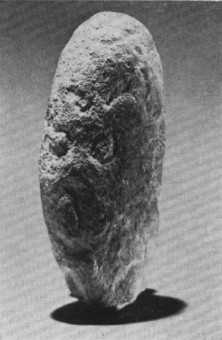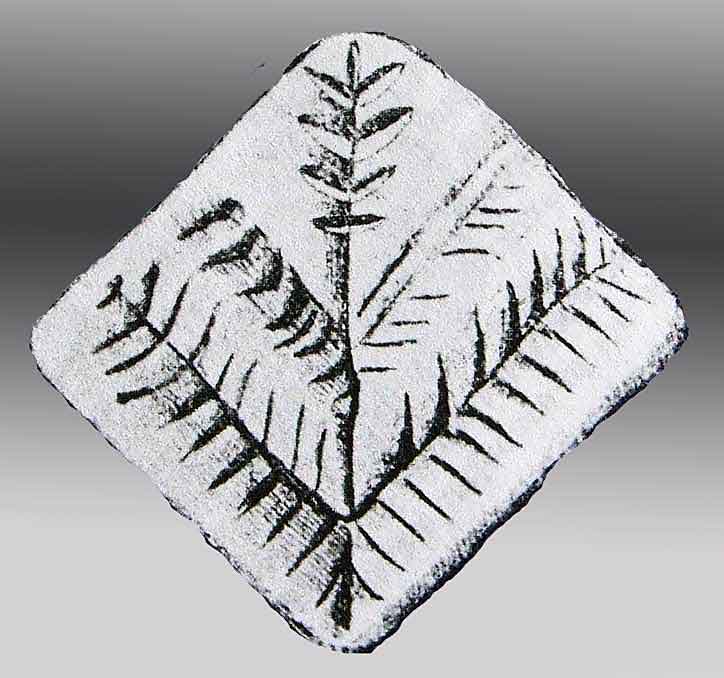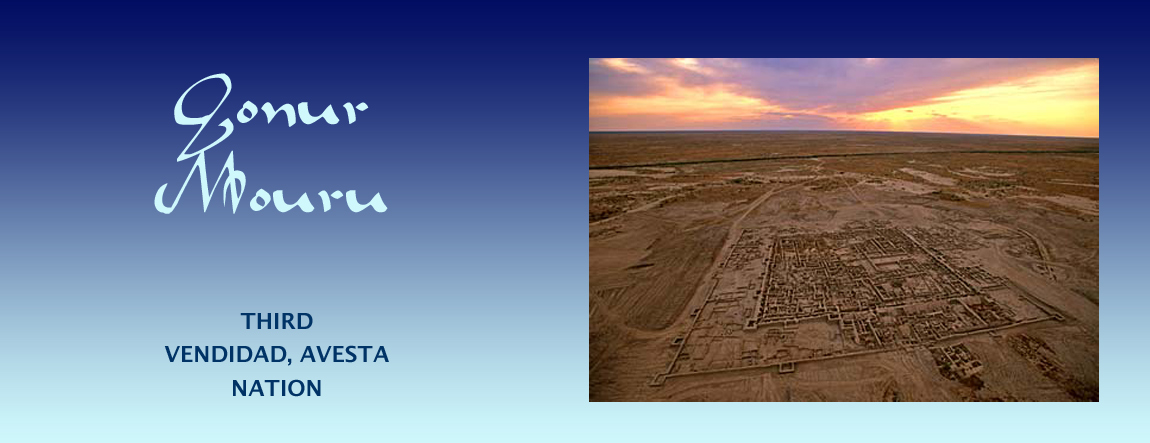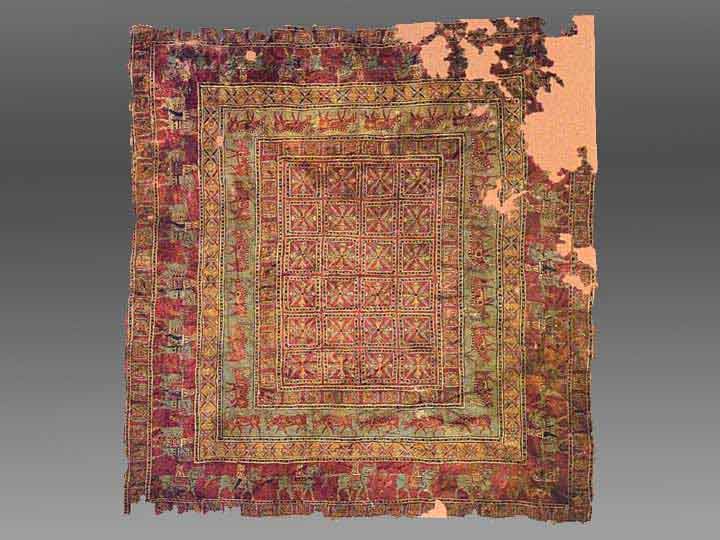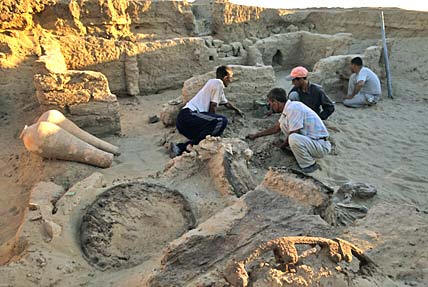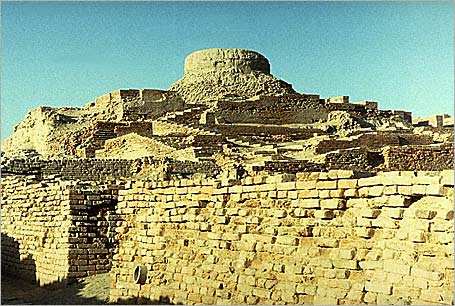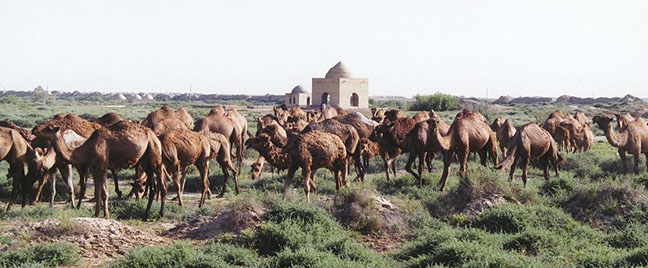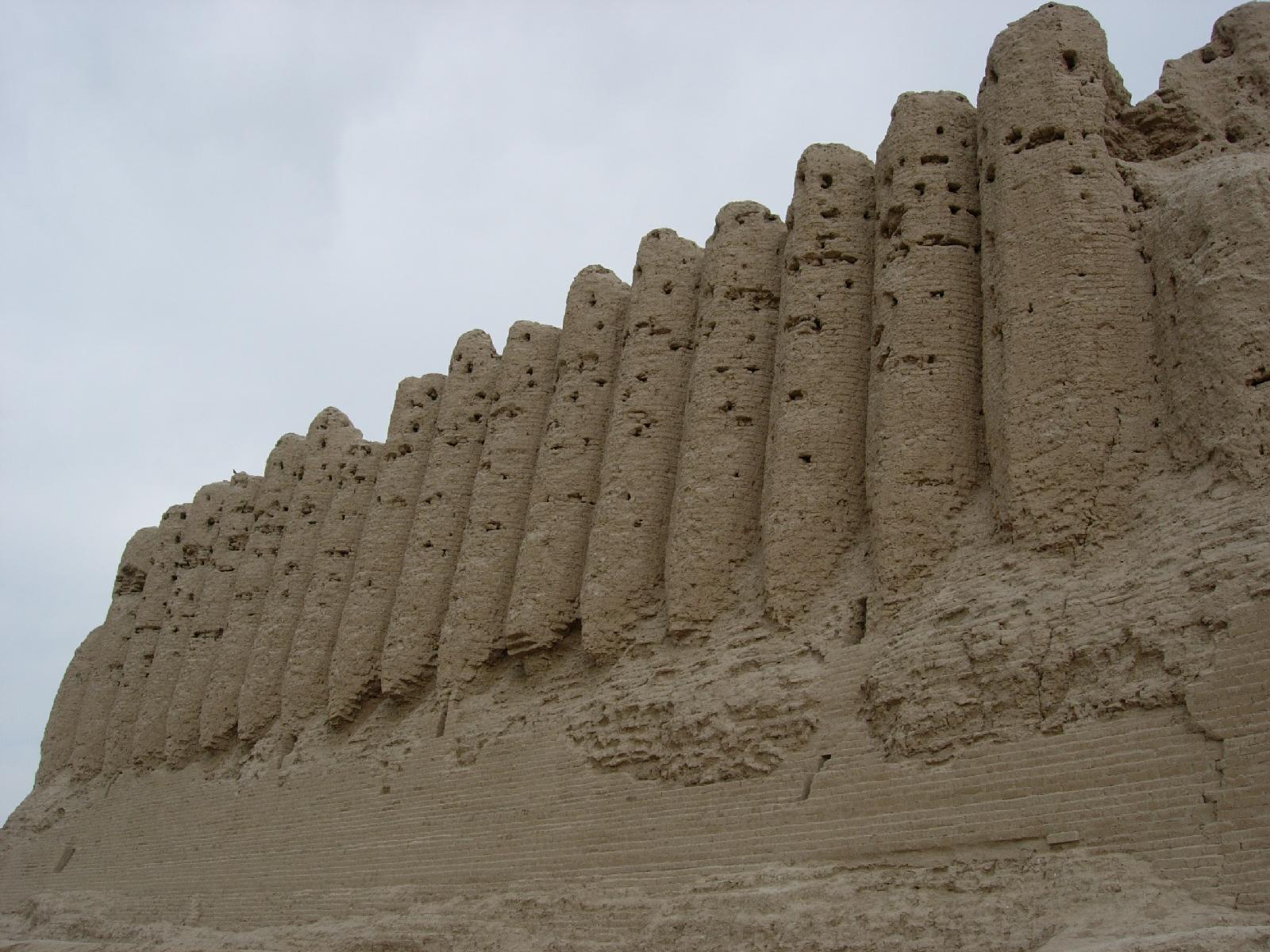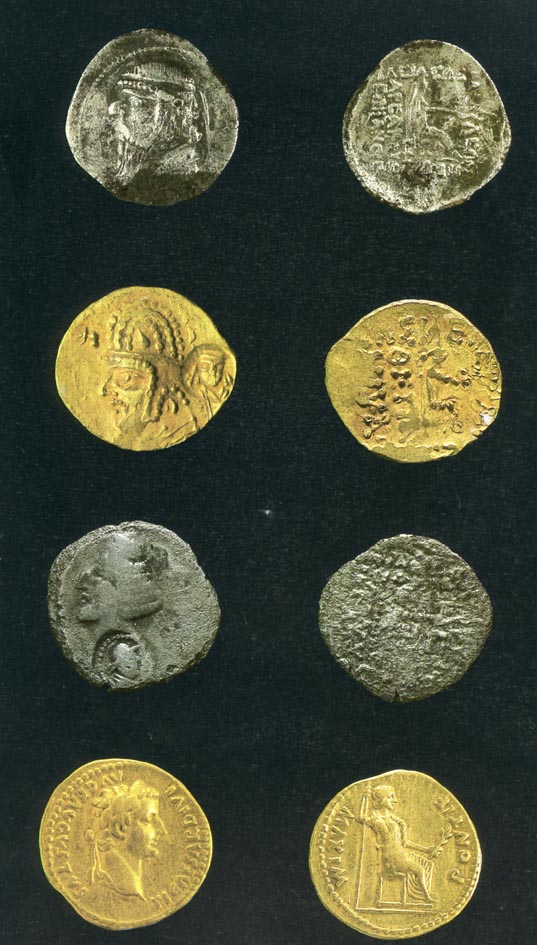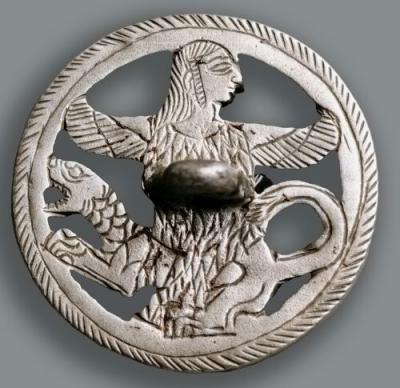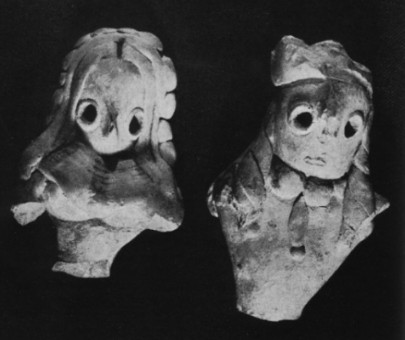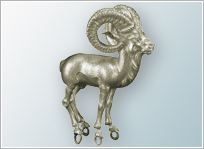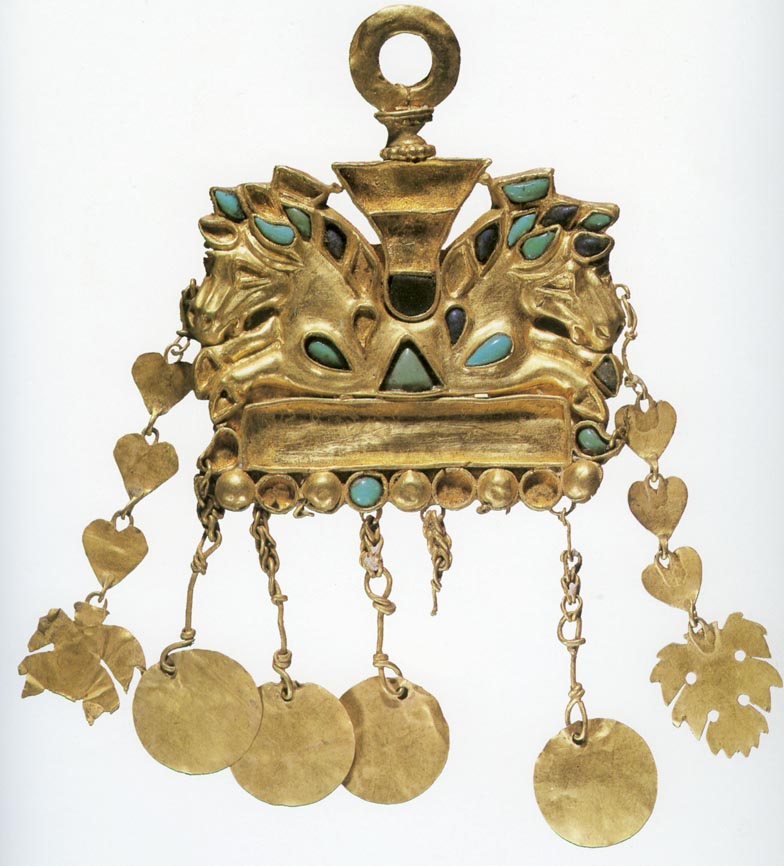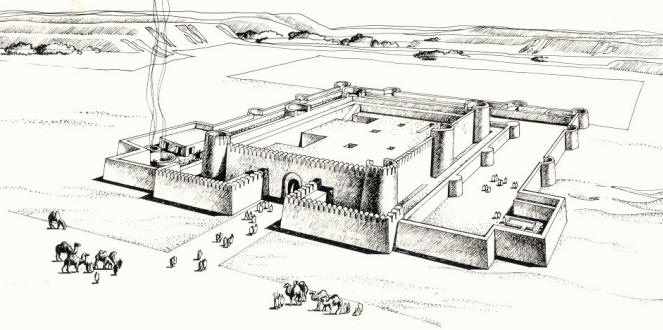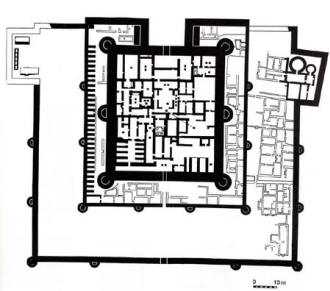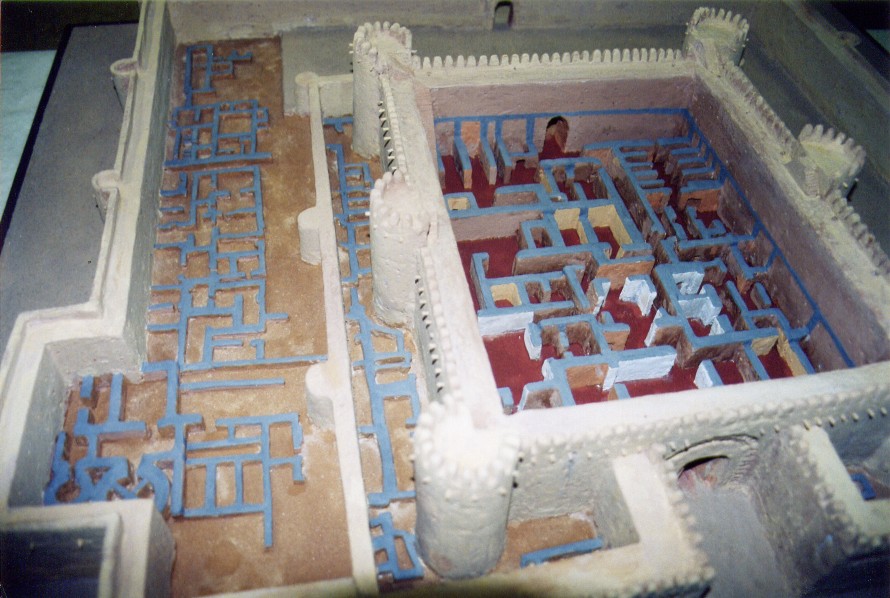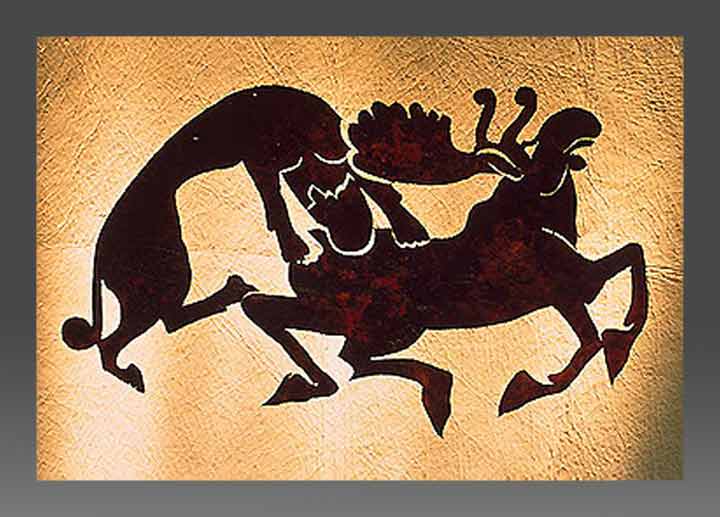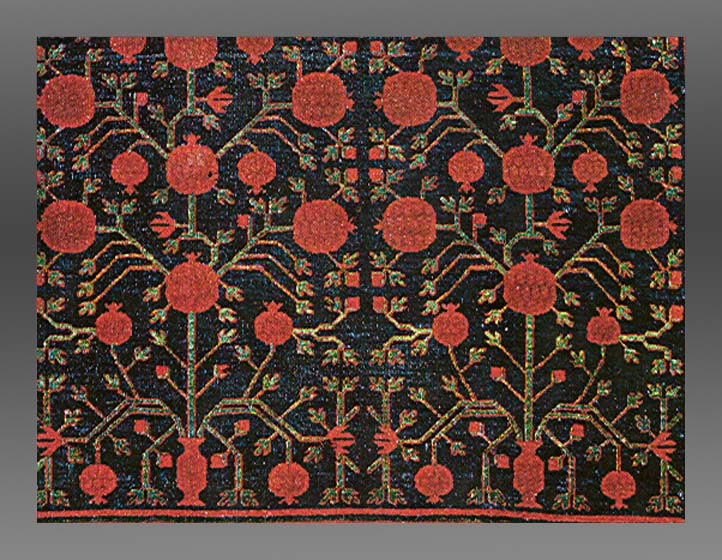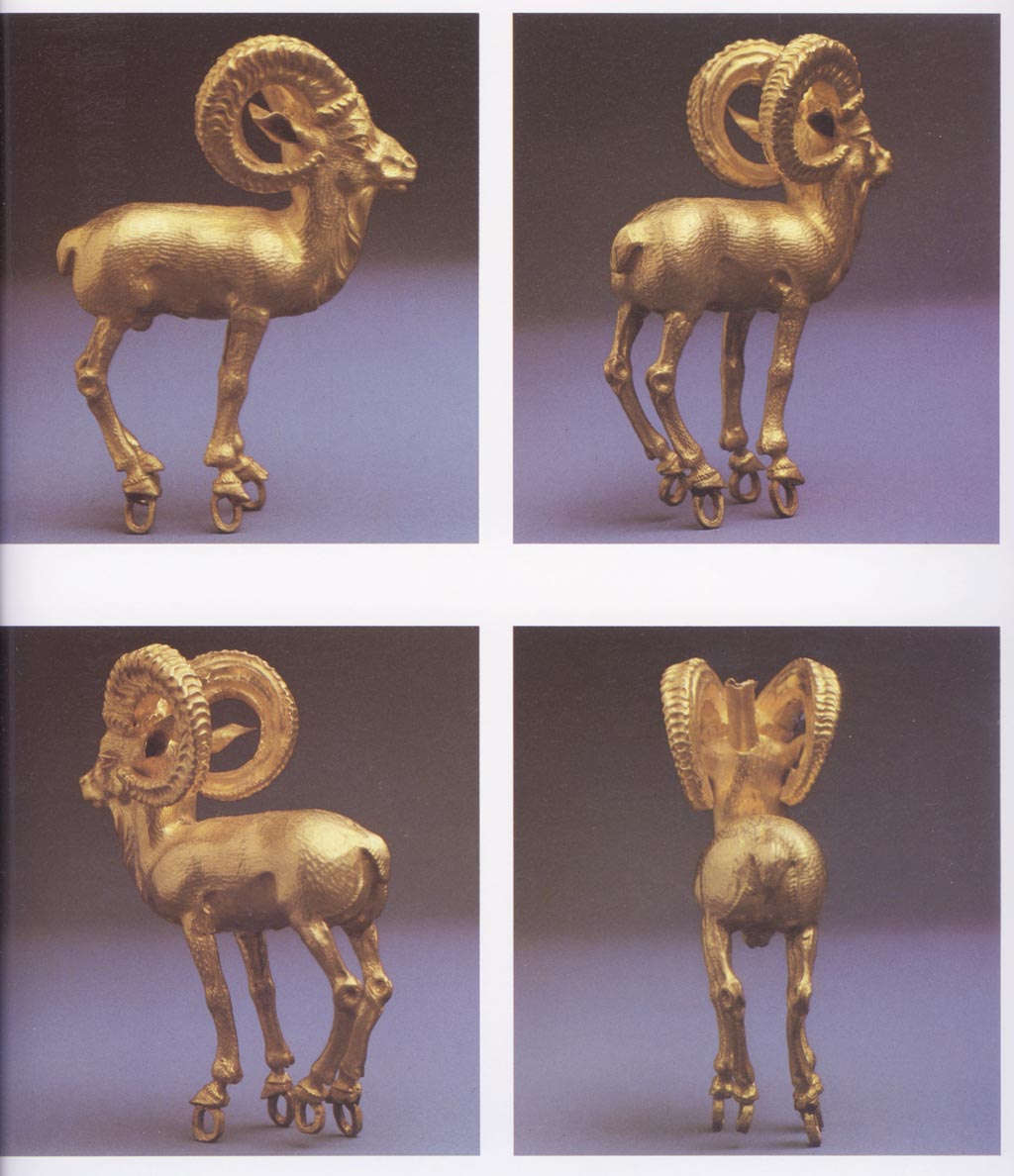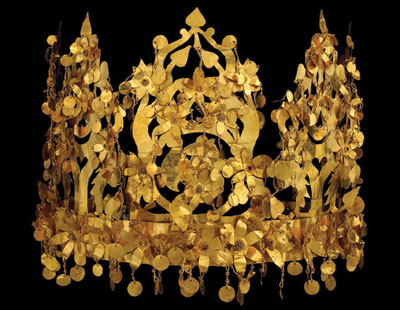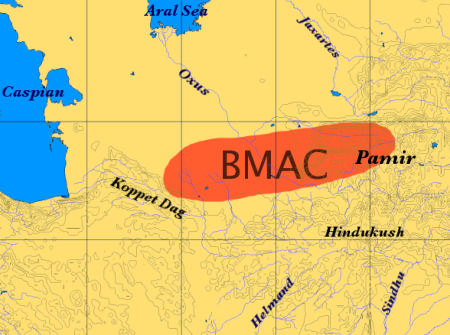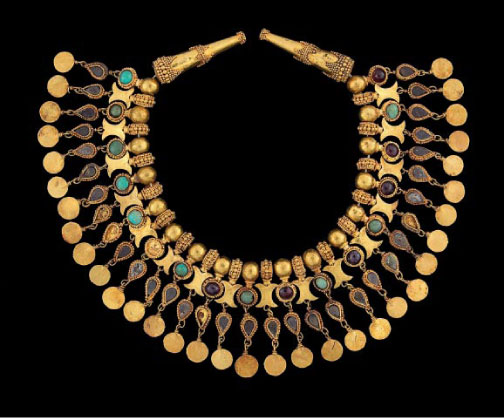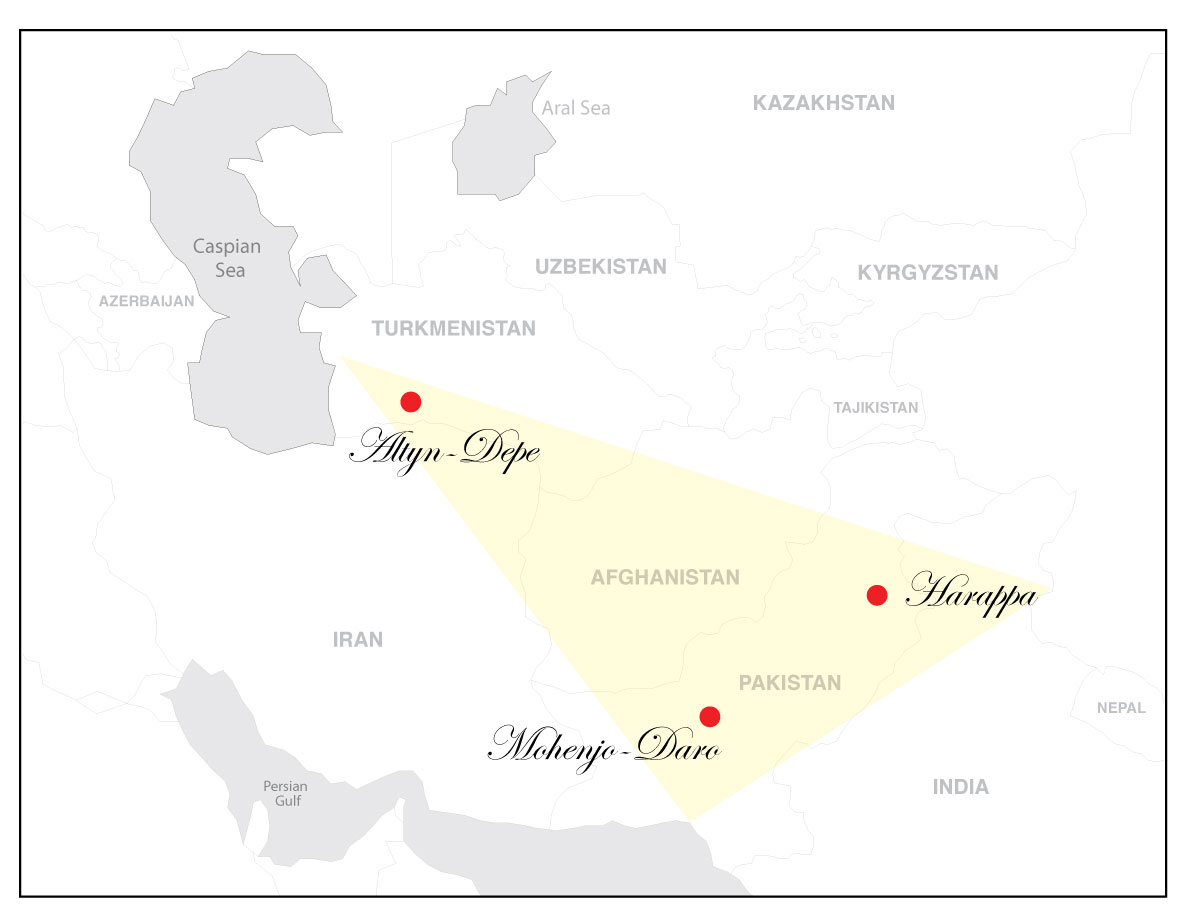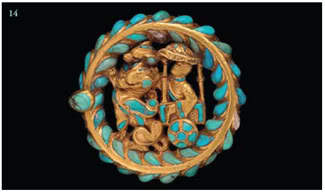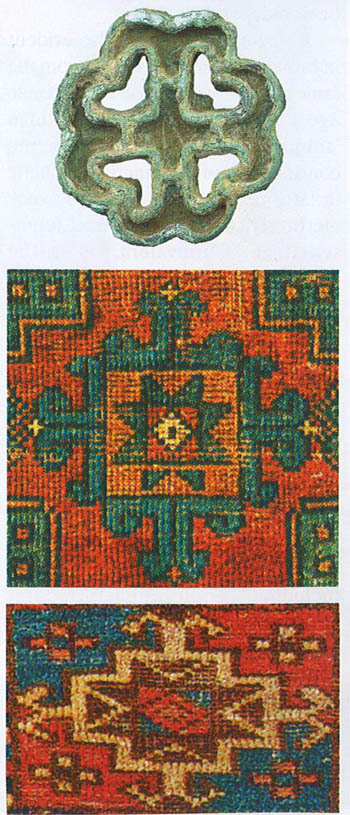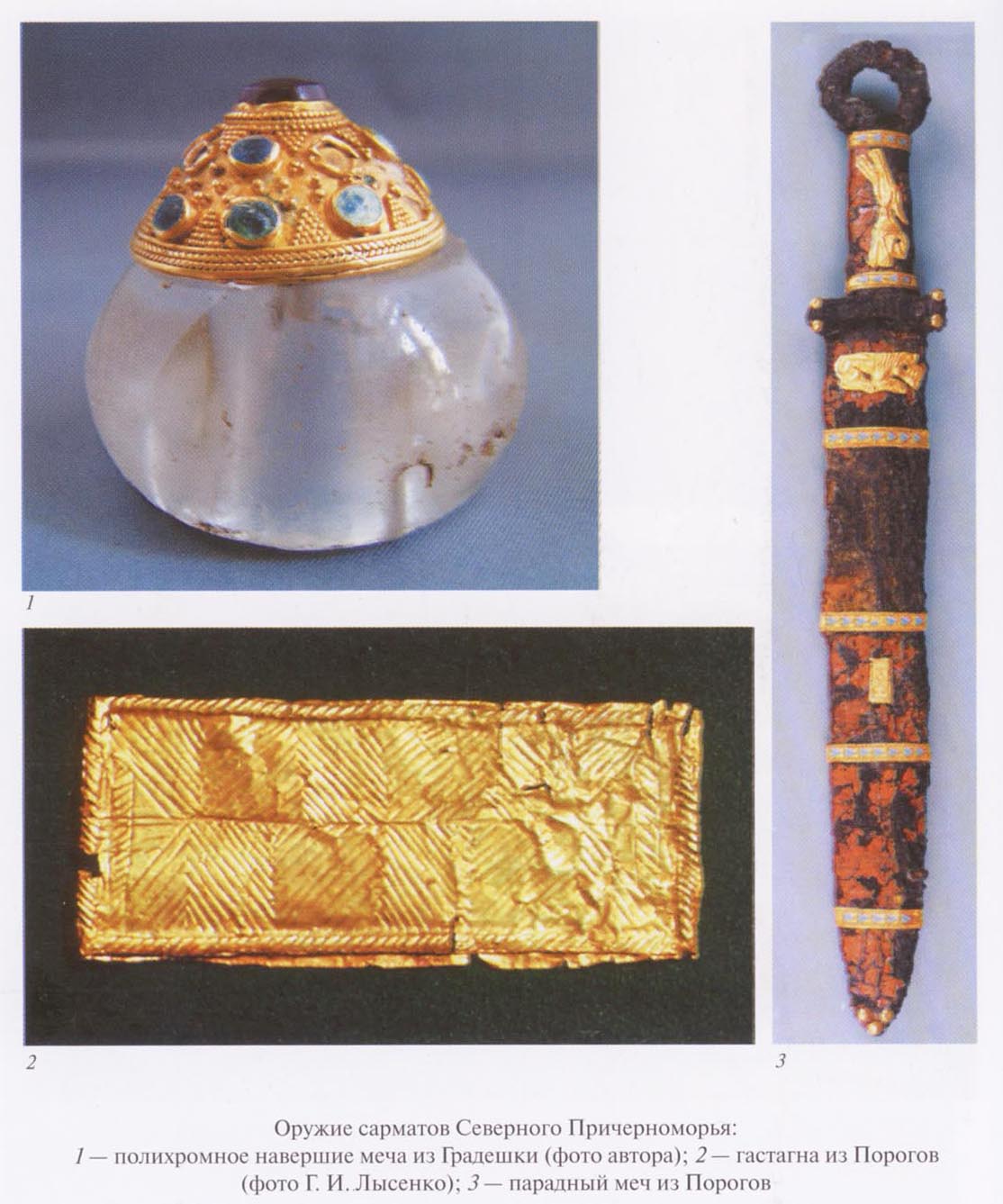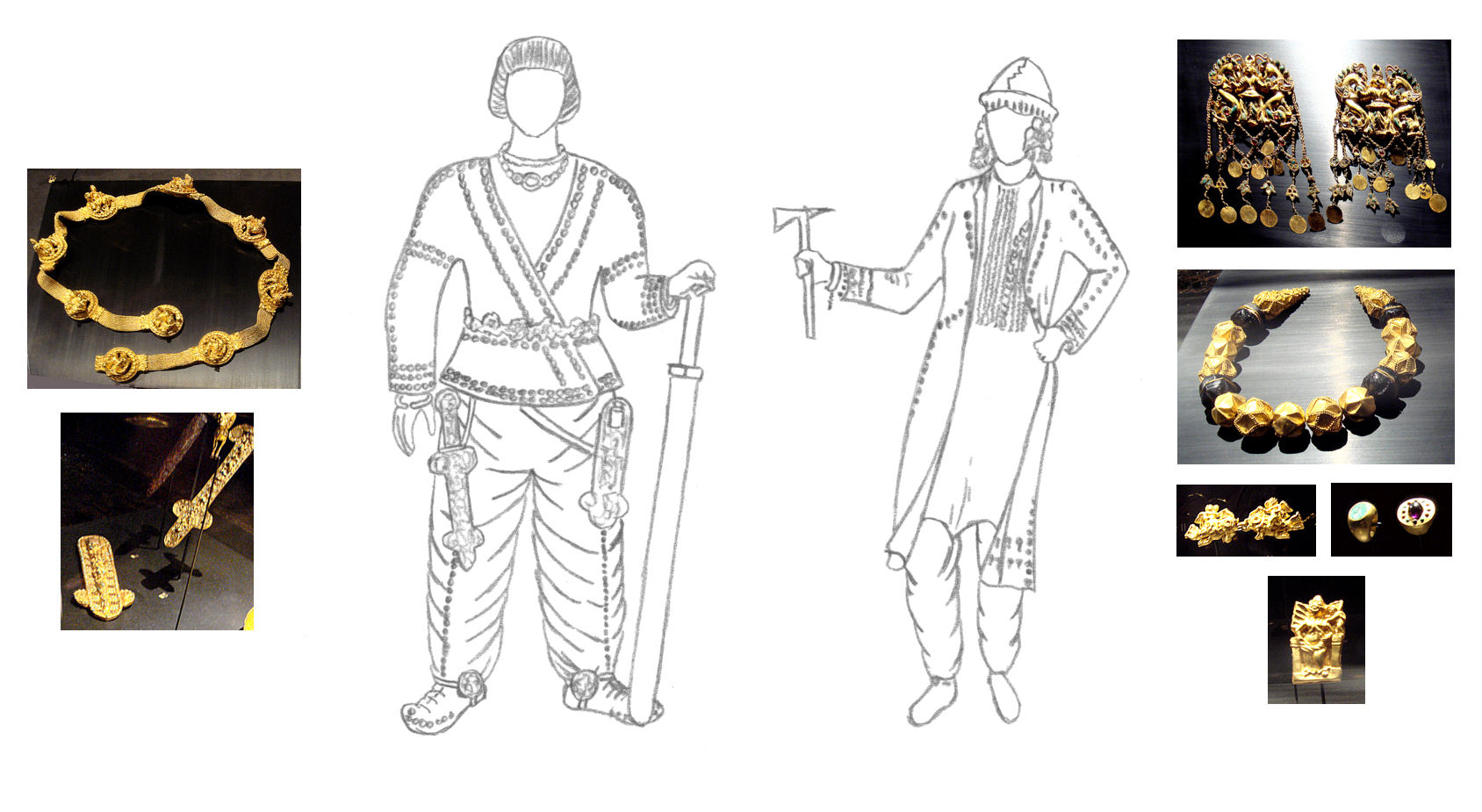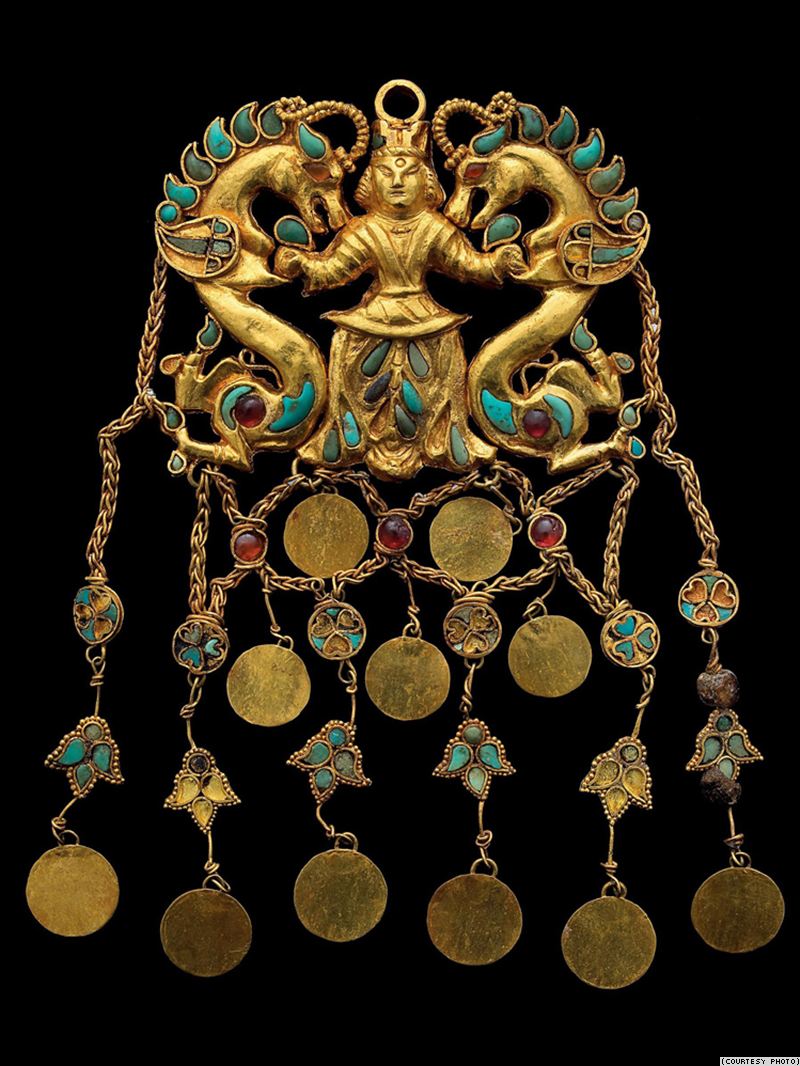 Mówimy o kulturach zaznaczonych na mapach archeologicznych jako Andronovo i BMAC
Mówimy o kulturach zaznaczonych na mapach archeologicznych jako Andronovo i BMAC
O Gonurze i innych ośrodkach aryjskiej cywilizacji, które odkryto na terytorium dzisiejszego Turkiestanu niewiele sobie poczytacie w języku polskim w internecie, więc niestety siłą rzeczy większość materiału będzie po angielsku. Z Gonurem, Merv i innymi starożytnymi grodami związany jest ośrodek cywilizacyjny, w którym upatruje się nową kolebkę cywilizacji, starszą i potężniejszą być może niż cywilizacja Międzyrzecza – czyli tak osławiona i rozreklamowana jako kolebka wszystkiego Mezopotamia. Olbrzymie terytorium, rozprzestrzeniające się od Morza Koszów (Koszpijskiego) i rosyjskich stepów Azji Centralnej po rzekę Okosz (Oxus) i Jezioro Orol (Aral) było najprawdopodobniej usiane kwitnącymi ośrodkami, które mogły bez problemu konkurować z wielkimi metropoliami Międzyrzecza. Wiele wskazuje na to, że dotychczasowy pogląd, który tradycyjnie wskazywał na Mezopotamię, dolinę Nilu i dolinę Indusu, jako kolejne miejsca powstania pierwszych cywilizacji, musi ulec zmianie.
Jeden z bezcennych skarbów kultury Słowiano-Indo-Irańczyków – Głowa z Kupruk, kamień, około 20.000 roku p.n.e. (Krąg kultur Arkajamy i Gonuru – Andronovo BMAC ale o wiele starszy zabytek)
W Polsce poświęcono tematowi nieco uwagi w roku 2007, kiedy te rewelacje wstrząsnęły środowiskiem archeologów. Dzisiaj, gdy wiemy, że tamten region jest i był obszarem, który uważa się za Kolebkę Prasłowian, ludu który możemy określić jako nierozdzielone jeszcze grupy Ariów- Słowian, Ariów Indyjskich i Ariów Irańskich, nie pisze się w ogóle na temat tamtego regionu, odkryć archeologicznych, skarbów kultury i wytworów materialnych jakie tam odkryto. Podobnie nikt prawie nie pisze o Arkaimie – innym ośrodku związanym z kulturą archeologiczną Andronovo – uważaną dzisiaj za prasłowiańską.
Wzór z Gonuru przenoszony przez wieki na dywanach tkanych od Ałtaju po Zakopane, a nawet po Budziszyn, do czasów współczesnych
Obydwa regiony (Arkaim i Gonur) są związane z tak zwaną grupą Indo-Irano-Słowiańska Ariów, uważaną przez genetyków za najstarszą, z której następnie wydzieliły się te trzy grupy: indyjska, irańska i słowiańska, już jako osobne – najprawdopodobniej w wyniku rozejścia się się w różnych kierunkach, lub zatrzymania i osiadania na określonych terytoriach, podczas gdy inna grupa wędrowała dalej. Są to wielkie ludy dzielące się następnie na liczne plemiona – ludzie pochodzący od wspólnego przodka o haplogrupie R1a – grupy powstałej jako mutacja genetyczna około 20.000 lat p.n.e – ludzie reprezentujący dzisiaj w potężnym odsetku haplotyp R1a1a (Polacy ponad 60%).
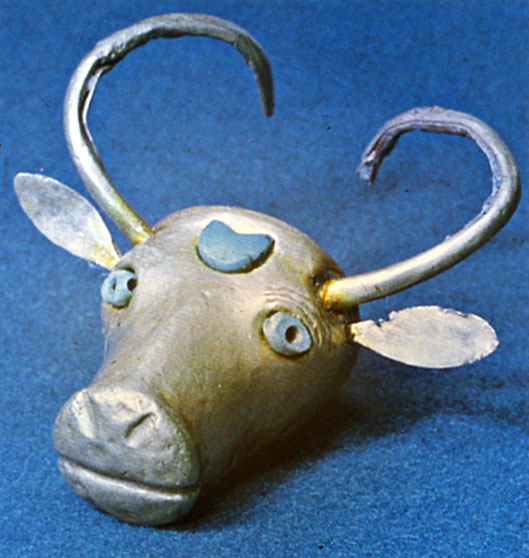 Jeden z licznych zabytków z Gonuru – i mówi się ze to była jakaś horda nomadów. W życiu nie słyszałem większej bzdury.
Jeden z licznych zabytków z Gonuru – i mówi się ze to była jakaś horda nomadów. W życiu nie słyszałem większej bzdury.
Human Origins / Prehistoric Culture
Central Asia’s Lost Civilization
The unveiling of a 4,000-year-old civilization calls into question conventional ideas about ancient culture, trade, and religion.
Viktor Sarianidi, barefoot at dawn, surveys the treeless landscape from a battered lawn chair in the Kara-Kum desert of Turkmenistan. „The mornings here are beautiful,” he says, gesturing regally with his cane, his white hair wild from sleep. „No wife, no children, just the silence, God, and the ruins.”
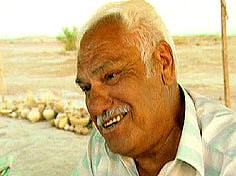 Viktor Sarianidi spends nearly half of Viktor Sarianidi spends nearly half ofevery year digging in Turkmenistan’s Kara-Kum desert. Courtesy of Kenneth Garrett |
Where others see only sand and scrub, Sarianidi has turned up the remnants of a wealthy town protected by high walls and battlements. This barren place, a site called Gonur, was once the heart of a vast archipelago of settlements that stretched across 1,000 square miles of Central Asian plains. Although unknown to most Western scholars, this ancient civilization dates back 4,000 years—to the time when the first great societies along the Nile, Tigris-Euphrates, Indus, and Yellow rivers were flourishing.
Thousands of people lived in towns like Gonur with carefully designed streets, drains, temples, and homes. To water their orchards and fields, they dug lengthy canals to channel glacier-fed rivers that were impervious to drought. They traded with distant cities for ivory, gold, and silver, creating what may have been the first commercial link between the East and the West. They buried their dead in elaborate graves filled with fine jewelry, wheeled carts, and animal sacrifices. Then, within a few centuries, they vanished.
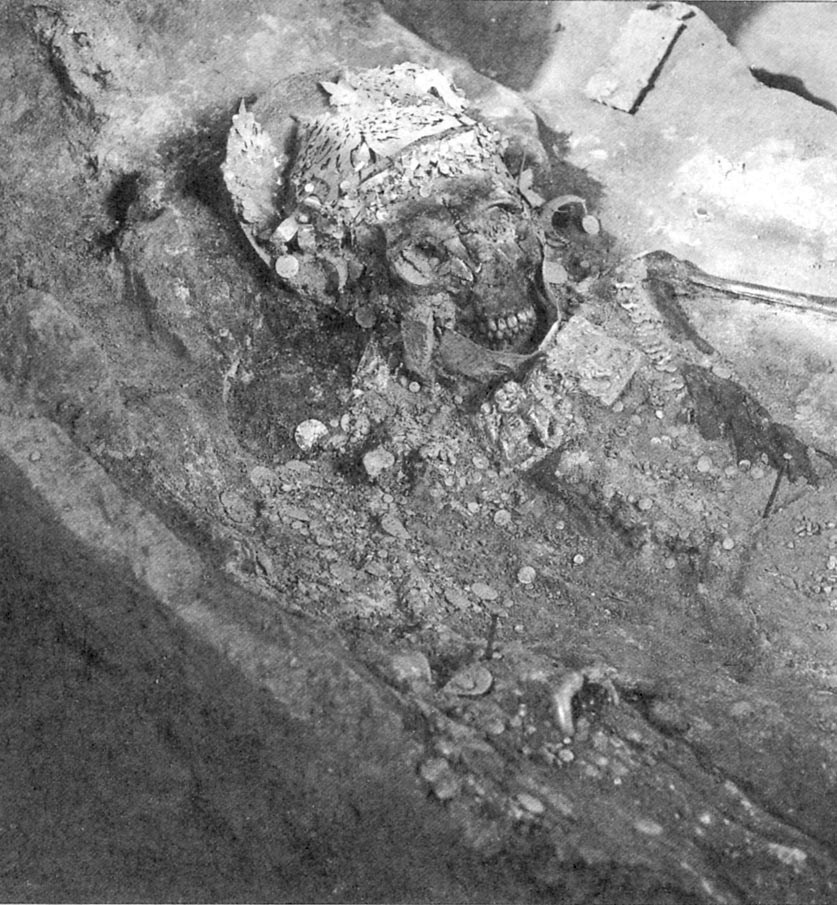 Grób i szkielet z Tillya Tepe (Afganistan), sensacji archeologicznej, miejsca gdzie znaleziono wiele fantastycznych skarbów które zaprezentujemy poniżej w tym artykule – Na zdjęciu powyżej odkrywca Tillya Tepe – Wiktor Sarianidi
Grób i szkielet z Tillya Tepe (Afganistan), sensacji archeologicznej, miejsca gdzie znaleziono wiele fantastycznych skarbów które zaprezentujemy poniżej w tym artykule – Na zdjęciu powyżej odkrywca Tillya Tepe – Wiktor Sarianidi
News of this lost civilization began leaking out in the 1970s, when archaeologists came to dig in the southern reaches of the Soviet Union and in Afghanistan. Their findings, which were published only in obscure Russian-language journals, described a culture with the tongue-twisting name Bactria-Margiana Archaeological Complex. Bactria is the old Greek name for northern Afghanistan and the northeast corner of Iran, while Margiana is further north, in what is today Turkmenistan and Uzbekistan. Through the region runs the Amu Dar’ya River, which was known in Greek history as the Oxus River. Western scholars subsequently used that landmark to dub the newly found culture the Oxus civilization.
The initial trickle of information dried up in 1979 when the revolution in Iran and war in Afghanistan locked away the southern half of the Oxus. Later, with the 1990 fall of the Soviet Union, many Russian archaeologists withdrew from Central Asia. Undeterred, Sarianidi and a handful of other archaeologists soldiered on, unearthing additional elaborate structures and artifacts. Because of what they have found, scholars can no longer regard ancient Central Asia as a wasteland notable primarily as the origin of nomads like Genghis Khan. In Sarianidi’s view, this harsh land of desert, marsh, and steppe may instead have served as a center in a broad, early trading network, the hub of a wheel connecting goods, ideas, and technologies among the earliest of urban peoples.
| Courtesy of Kenneth Garrett |
Harvard University archaeologist Carl Lamberg-Karlovsky believes the excavation at Gonur is „a major event of the late 20th century,” adding that Sarianidi deserves credit for discovering the lost Oxus culture and for his „30 consecutive years of indefatigable excavations.” To some other researchers, however, Sarianidi seems more desert eccentric than dispassionate scholar. For starters, his techniques strike many colleagues as brutish and old-fashioned. These days Western archaeologists typically unearth sites with dental instruments and mesh screens, meticulously sifting soil for traces of pollen, seeds, and ceramics. Sarianidi uses bulldozers to expose old foundations, largely ignores botanical finds, and publishes few details on layers, ceramics, and other mainstays of modern archaeology.
His abrasive personality hasn’t helped his cause, either. „Everyone opposes me because I alone have found these artifacts,” he thunders during a midday break. „No one believed anyone lived here until I came!” He bangs the table with his cane for emphasis.
Sarianidi is accustomed to the role of outsider. As a Greek growing up in Tashkent, Uzbekistan, under Stalinist rule, he was denied training in law and turned to history instead. Ultimately, it proved too full of groupthink for his taste, so he opted for archaeology. „It was more free because it was more ancient,” he says. During the 1950s he drifted, spending seasons between digs unemployed. He refused to join the Communist Party, despite the ways it might have helped his career. Eventually, in 1959, his skill and tenacity earned him a coveted position at the Institute of Archaeology in Moscow, but it was years before he was allowed to direct a dig.
Kolebka cywilizacji w Azji Środkowej
poniedziałek, 13 sierpnia 2007
Mohenjo Daro. Źr. Wikipedia, fot. na lic. cc-by-sa 1.0.
Wykopaliska ze stanowisk w Azji Środkowej wywołały poruszenie w archeologicznym światku. Wiele wskazuje na to, że dotychczasowy pogląd, który tradycyjnie wskazywał na Mezopotamię, dolinę Nilu i dolinę Indusu, jako kolejne miejsca powstania pierwszych cywilizacji, musi ulec zmianie.
Olbrzymie terytorium, rozprzestrzeniające się od rosyjskich stepów Azji Centralnej po Zatokę Perską, do niedawna postrzegane jako „zaścianek” i peryferia cywilizacji, było najprawdopodobniej usiane kwitnącymi ośrodkami, które mogły bez problemu konkurować z wielkimi metropoliami Międzyrzecza. Takie wnioski zostały wyciągnięte przez badaczy uczestniczących w konferencji International Association for the Study of Early Civilizations in the Middle Asian Intercultural Space (Międzynarodowe Stowarzyszenie dla Studiów Wczesnych Cywilizacji Międzykulturalnej Przestrzeni Środkowoazjatyckiej), która odbyła się w Rawennie we Włoszech w lipcu tego roku.
Przykładem takiego ośrodka jest na pewno starożytne miasto znalezione przez zespół archeologów, pracujący pod kierownictwem Yousefa Madjidzadeha w pobliżu dzisiejszego Jiroft we wschodnim Iranie, przebadane w ciągu kilku ostatnich lat. Ta metropolia, funkcjonująca między połową do późnego 3-ciego tysiąclecia p.n.e., zajmowała obszar większy niż 2 kilometry kwadratowe i mogła konkurować pod względem rozległości i bogactwa ze współczesnym jej Ur, ważnym ośrodkiem Mezopotamii.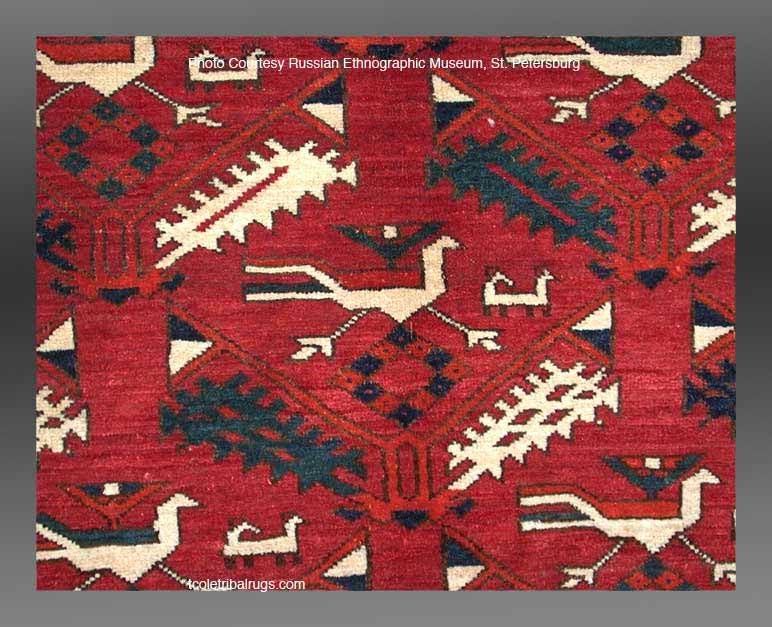
Dywan turkiestański współczesny, wzorowany na dywanie z XVIII wieku. Identyczny lecz góralski-harski z Wisły wisiał u mnie w domu jeszcze 30 lat temu.
Zespół badaczy odkrył tam ciekawe dzieła sztuki, jak ok. 400 odcisków pieczęci, wykonanych między 2480 a 2280 r. p.n.e. Zdaniem Holly Pittman, profesor University of Pennsylvania i specjalistki od bliskowschodniej gliptyki, tylko jedna na dziesięć pieczęci mogła pochodzić z Mezopotamii i dwie z doliny Indusu. Reszta to najprawdopodobniej wyrób lokalny. Wykopaliska na pobliskim cmentarzysku dostarczyły interesujących rzeźbionych naczyń z ciemnego kamienia, które były wyrabiane w tym rejonie. Naczynia te docierały drogą handlową do odległej Mezopotamii. Także na tym cmentarzu dokonano wykopu, który dowodzi, że na w tym rejonie już około 4000 r. p.n.e. znajdowało się osiedle, co świadczy o tym, że miasto opodal Jiroft nie było jedynie krótkotrwałą efemerydą, ale efektem długiej tradycji osadniczej. Inne podobne ośrodki znaleziono na całym wspomnianym terytorium. Na przykład w Szahr-i Sochta, na północ od Jiroft, istniało wielkie miasto między 2550 a 2400 r. p.n.e.
W III tysiącleciu p.n.e. funkcjonowała również rozległa sieć handlowa, rozprzestrzeniająca się od Półwyspu Arabskiego po Azję Centralną, czego dowodzą znaleziska miedzianych naczyń z Omanu na całym tym obszarze, najprawdopodobniej aż po Indie. W dzisiejszym Turkmenistanie rosyjscy archeolodzy odkryli dwa ważne ośrodki, Gonur i Ałtyn Tepe, które działały pod koniec III tysiąclecia p.n.e. Zdaniem Wiktora Sarianidiego, który kieruje wykopaliskami w Gonur, znajdujący się tam ośrodek aktywnie handlował z Mezopotamią i Indiami.
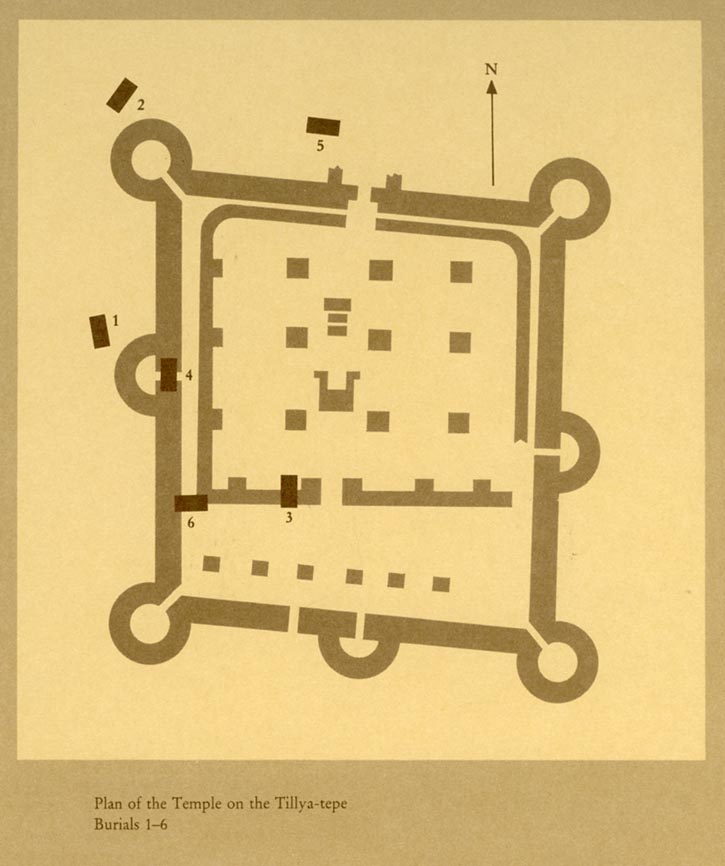 Plan Tillya Tepe – gdzie ekspedycja afgańsko-rosyjska prowadzona przez Wiktora Sarianidi dokonała odkrycia bezliku skarbów archeologicznych
Plan Tillya Tepe – gdzie ekspedycja afgańsko-rosyjska prowadzona przez Wiktora Sarianidi dokonała odkrycia bezliku skarbów archeologicznych
Elementem wspólnej kultury na tym obszarze mogą być spotykane prawie na każdym stanowisku masywne, ceremonialne platformy, które występowały od Mezopotamii po Afganistan. Nawet w indyjskim Mohenjo-Daro można się doszukać takiej platformy. Niektórzy badacze sugerują, że ten obszar kulturalny dysponował także własnym pismem, do niedawna uważanym za pismo proto-elamickie. Jednak ta kwestia wciąż wymaga dalszych badań.
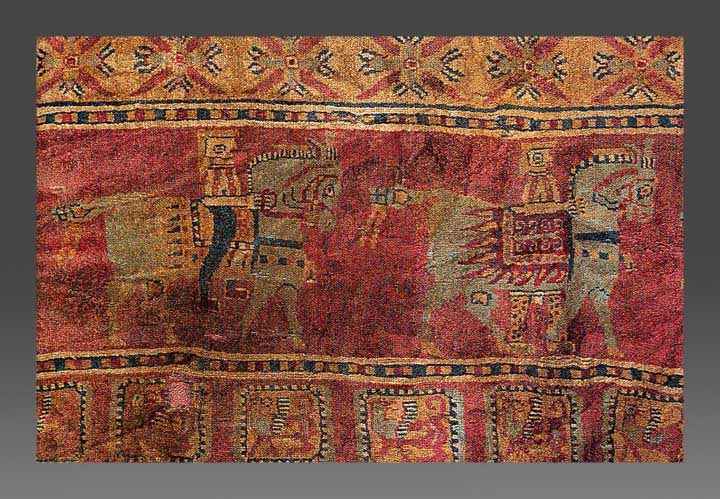 dywan z Pazyryku 3 wiek p.n.e.
dywan z Pazyryku 3 wiek p.n.e.
Bujnie rozwijające się ośrodki spotkał jednak niespodziewany koniec. Miasta zostały opuszczone, handel przestał funkcjonować, a rozwój cywilizacji zatrzymał się na wiele stuleci. Kryzys szczególnie dotkliwie dotknął wyżynę Irańską, gdzie zasadniczo nie znaleziono ośrodków datowanych na II tysiąclecie p.n.e. Podobnie do 1800 r. p.n.e. także ośrodki w dolinie Indusu zostały opuszczone. Nie są znane przyczyny tych wydarzeń. Przypuszcza się, że mógł być to wynik gwałtownych zmian klimatycznych. Niektóre badania wskazują na wielkie susze, panujące w tym czasie. Wynikiem tego mógł być upadek handlu, który pozbawił ludzi środków utrzymania, a także niestabilność polityczna. Niektóre ówczesne miasta, jak Jiroft, Szahdad, Gonur i Szahr-i Sochta nigdy już się nie odrodziły.
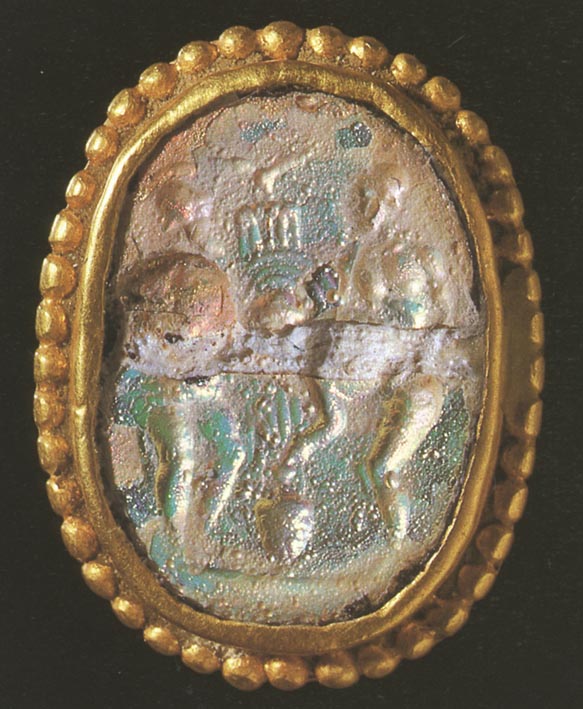 Skarb z Tillya Tepe – plakietka heraklidańska
Skarb z Tillya Tepe – plakietka heraklidańska
Niezależnie od zagadkowego końca, ośrodki Azji Środkowej poważnie zmieniają punkt widzenia badaczy na najwcześniejsze losy cywilizacji. Nie ma już wątpliwości, że ludzkość na całym obszarze Azji Zachodniej tworzyła rozwinięte i kwitnące ośrodki miejskie, które niejednokrotnie były silnymi centrami kulturalnymi. Każdy z nich miał swoją specyfikę i niepowtarzalne cechy, które powodują, że obiekty wytworzone w tych centrach można łatwo rozpoznać na innych obszarach kulturowych. Niemniej jednak wielu badaczy wciąż widzi w Mezopotamii główne centrum cywilizacji, które w III tysiącleciu p.n.e. nadawało ton i inspirowało inne kultury. Niektórzy zdają się także podważać część wyników badań archeologów, którzy spotkali się w Rawennie. Następne lata prawdopodobnie odpowiedzą na pytanie, jaki faktyczny wpływ i znaczenie miały kultury Azji Środkowej.
Tytus Mikołajczak
…
Rosyjska ekspedycja archeologiczna odnalazła świątynię sprzed 5 tys. lat, w której przedmiotem kultu prawdopodobnie była woda. Stało się to w Turkmenii, w starożytnej osadzie Gonur, około 300 kilometrów od stolicy kraju Aszchabadu. Niedaleko odkrytego wcześniej pałacu królewskiego znaleziono szeroki na 50 metrów i głęboki na około 3 metry basen. Kierujący wykopaliskami Wiktor Sarianidi mówi, że miejsce to wykorzystywano w celach religijnych…
Merv
Histmag – Gonur kolebką Haplogrupy R, R1 i R1a1
Gonur, ros. ГОНУР, nad rzeką Murgab (Мургаб)
W indoeuropeistyce od dawna wskazuje się na Turkmenistan oraz rejon jeziora Aralskiego (Uzbekistan/Kazachstan), skąd mieliby indoeuropejscy Ariowie wyemigrować do Indii i Iranu. Na to też miałyby wskazywać pewne wypowiedzi w księgach Wedy i Awesty.
Teraz, po odkryciu na pustynui Kara-kum w Turkmenistanie starożytnej cywilizacji Gonur, ros. ГОНУР, nad rzeką Murgab (Мургаб) datowanej na przełom III i II tysiąclecia p.n.e, a upadłej około połowy II tysiąclecia i równoległej do równie niedawno odkrytej cywilizacji Arkaim (АРКAИМ) na poludniowym Uralu
mówi się i pisze, że jest to jedna z pięciu największych cywilizacji starozytności (obok egipskiej, mezopotamskiej, Indus i chińskiej) i że należy ją wiązać z Indoeuropejczykami.
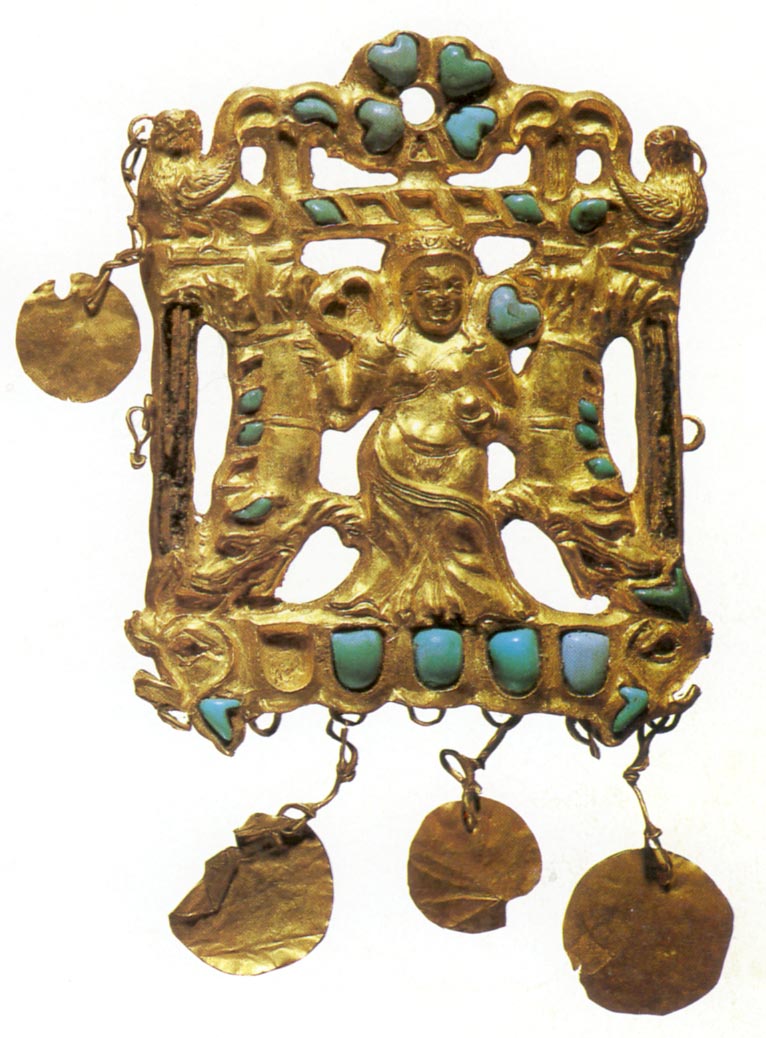 Skarb z Tillya Tepe – plakietka
Skarb z Tillya Tepe – plakietka
Dlatego np. na portalu Eurasianet tytuł:
„Turkmenistan pretenduje do roli kolebki cywilizacji”:
http://russian.eurasianet.org/departments/insight/articles/eav052107ru.shtml
Odkrycie tej wspaniałem cywilizacji (niestety niepiśmiennej) zawdzięcza się archeologowi Wiktorowi Sarianidiowi (Виктор Сарианиди), pracującemu tam od 1972 do dziś w ramach Ekspedycji Margianskiej („Археологический комплекс Бактриа-Маргиана” BMAC).
http://www.planetguide.ru/krugosvetka/ekspeditsii/margianskayaekspedit/gonurdepe/
Poszukajmy bliższych informacji w necie.
Tu warto wiedzieć, że w genetyce wskazuje sie na Azję Centralną (właśnie w omawianym rejonie, między południowym Uralem a Turkmenistanem) jako miejsce powstania haplogrupy R, R1 i jej podgrup.
Mapa Firmy FTDNA od roku 2009 tam wskazuje kolebkę już haplogrupy P, podczas gdy kolebkę haplogrupy R nieco bardziej na północ – w rejonie Uralu, a R2 bardziej na wschód.
Warto też przeczytać w j. polskim temat pokrewny.
http://www.polskieradio.pl/nauka/artykul.aspx?id=13274
Prawdę jednak mówiąc, to stwierdzony upadek kultury kompleksu BMAC, do którego należy Gonur i kompleksu Andronovo około połowy II tysiąclecia kojarzy się z migracjami na południe:
wcześniej Protodrawidowie, haplogrupa R2 (z Kompleksu BMAC)
i nieco później Ariowie, haplogrupa R1a1a (z kręgu kultury Andronovo).
« Ostatnia zmiana: 18 Czerwiec 2010, 09:27:20
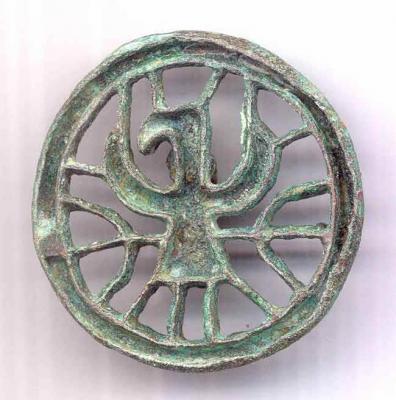 Skarby z Gonur – pierwowzór Orła Białego Polaków
Skarby z Gonur – pierwowzór Orła Białego Polaków
Turkmenistan Landmarks – Gonur-Depe
Among the sand s of east ern part of the Kara-Kum Desert archeologists found the ruins of monumental fortresses and cathedrals capable of compet ing with the similar structures of Assyria and Babylon . In 1992 the archaeologists open ed a huge Gonur-Depe necropolis.
The entombments contained numerous utensils, mirrors, cosmetic vessels, silver decorations, alabaster and ceramic vases and a great variety of other artifacts dated 3,000 B.C.
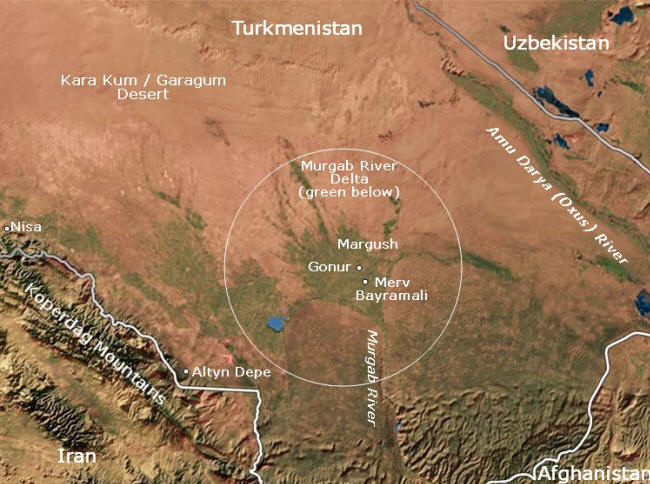 |
| Murgab delta and oasis (circled) in the south of Turkmenistan The Murgab river spreads out and disappears into the Kara Kum desert to the north |
Mouru & Murgab River Delta
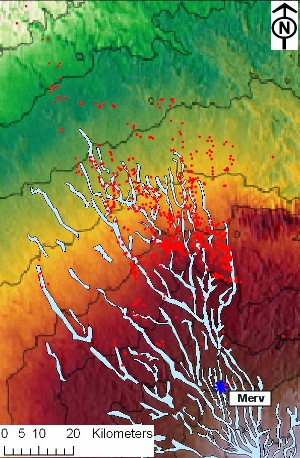 |
| Distribution of archaeological sites (in red) in the Murgab Delta Photo credit: University of Bologna |
Mouru or Mourum, the third Vendidad nation, is generally thought to have included the Murgab river delta and the region around Merv, now a part of southern Turkmenistan. Ruins of over 150 ancient settlements dating back to the early Bronze Age (2500-1700 BCE) have been found in the the delta region covering an area of more than 3000 sq. km. and which consisted of 78 oasis. There are reports that the earliest agricultural settlements may date as far date as the 7th millennium BCE.
The earlier 3rd millennium BCE settlements (Kelleli, Adji Kui, Taip, Gonur, and Togolok / Togoluk) are found to the north of the oasis, where in ancient times, the Murghab river came to the surface (see image to the right). It appears that the development of more advanced irrigation techniques in the early Iron Age, enabled the start of settlements south towards the ancient city of Merv which appears to have been an Achaemenian era (519-331 BCE) administrative centre or capital of the country which the Achaemenians called Margush.
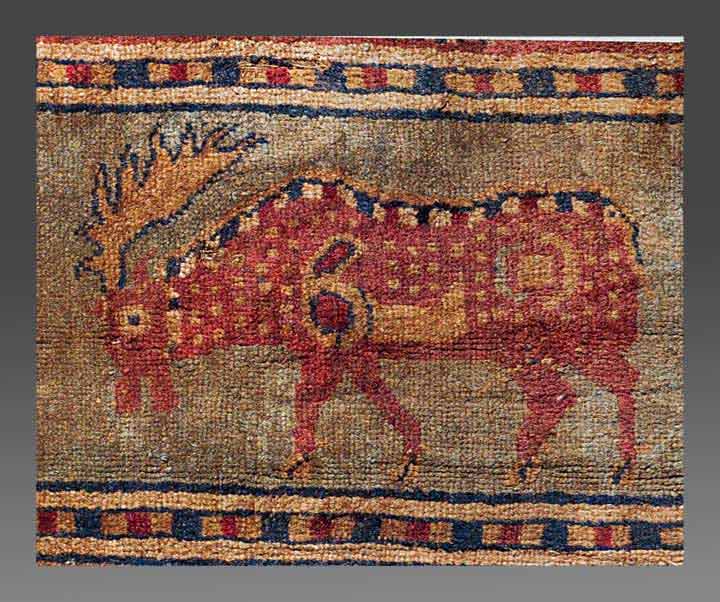 Dywan z Gonur – nieśmiertelny słowiański motyw jelenia
Dywan z Gonur – nieśmiertelny słowiański motyw jelenia
The Region & Zoroastrianism
In trying to understand if the region was home to Zoroastrians, it is important to bear in mind that Zoroastrians have seldom lived in exclusively Zoroastrian communities. In listing the nations after Airyana Vaeja, the Vendidad cites non-Zoroastrian traits in many of the nations, indicating that that the Aryan Zoroastrians lived in multi-cultural communities – communities that were not exclusively Zoroastrian or Aryan. In addition, because ancient Zoroastrians did not worship in temples, because they did not bury their dead, and because they were careful about defiling the environment with garbage, they left scant evidence of their presence.
What we learn from the archaeological findings under the tepe or depes in the Murgab region supports the history contained in the Avesta, a history we have outlined in our pages on the Aryans.
Skarb Kręgu Gonur – Bogtoharskie złoto z Tillya Tepe – pierwowzór Zaratusztriańskiego symbolu Ognia i Koła Życia (6.000 p.n.e.)
Tepe or Depe
Tepe or depe is a Turkoman word for a mound and is synonymous with the word tell used in the Middle East to denote mounds or hills. In treeless areas, such geographic features often indicate ancient settlements formed from mud-brick structures that later human occupation have compressed over time into artificial hills sometime consisting of the different layers of later construction, each with different a dating. The lower layers are therefore normally the older layers.
The largest of the settlements uncovered is Gonur-Tepe.
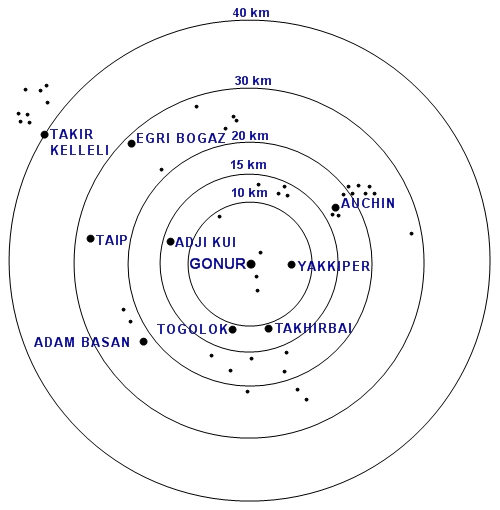 |
| Gonur-Tepe & surrounding tepe settlements |
Gonur
The Archaeological Site
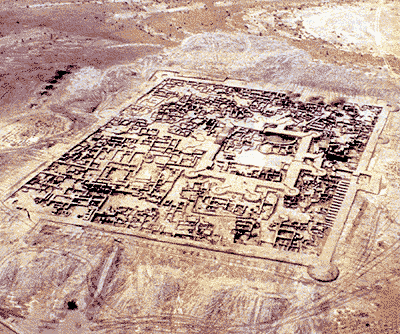 |
| Aerial view of Gonur-Tepe’s southern section (?) Photo credit: Various. Country Turkmenistan & Stantours |
The largest of all the ancient settlements uncovered in the Murgab delta is Gonur-Depe or Gonur-Tepe. Gonur is located seventy kilometres north of the ruins of Merv and a three-hour drive from Mary in an area that is now sparsely populated.
The Gonur site occupies an area of about 55 hectares and consists of the main settlement in the northern section of the site and a smaller (130 x 120 m) area south of the main settlement.
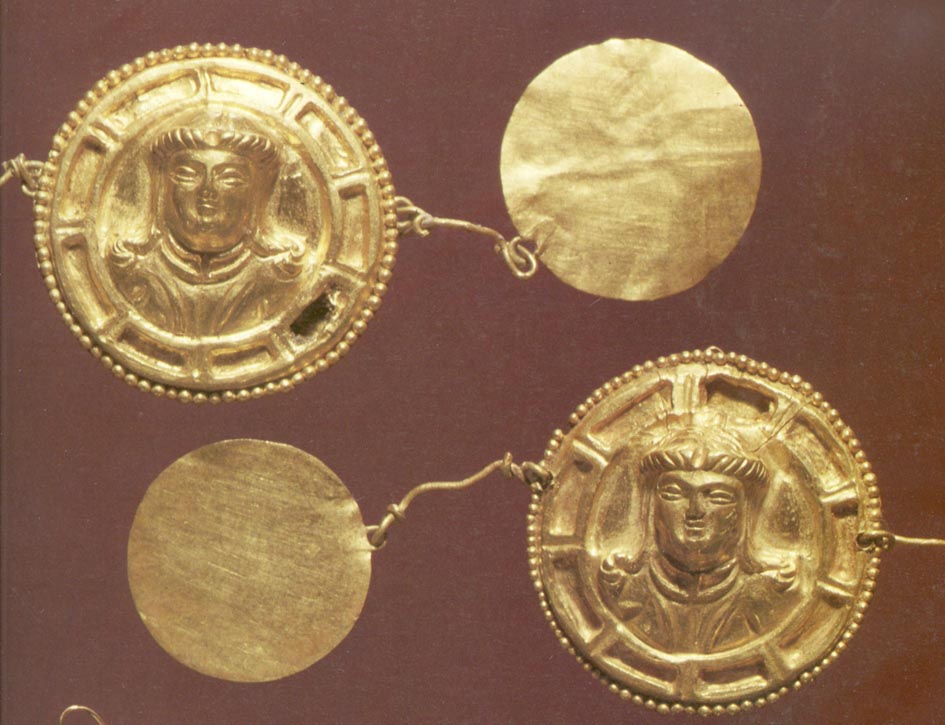 Skarb z Tillya Tepe – medalion
Skarb z Tillya Tepe – medalion
In the centre of the northern section is a fortified area containing a palace-like complex.
The smaller three hectare southern section consists of a wide 8-10m high walled 'fortress’ with round towers at its corners similar to the structure in the aerial photograph to the left. The walls enclosed residences and possibly a temple.
Reference:
Excavations at Southern Gonur, by V. Sarianidi, 1993, British Institute of Persian Studies.
» Brief History of Researches in Margiana at Museo-on.com
» Temples of Bronze Age Margiana: traditions of ritual architecture by Viktor Sarianidi
Figurki bogiń – 2300 pne (Mother goddess figurines, right, from Mundigak, left, from Deh Morasi Ghundai, 3rd Millennium B.C. (h. 5cm))
Description of Ancient Gonur
Gonur was a large town for the times and home to thousands of residents. The town had carefully designed streets, drains, temples and homes. The surrounding fields and orchards were watered using lengthy canals that the residents had dug from glacier-fed rivers. Since the rivers were fed by glaciers and since the framers did not have to rely on rain for irrigation, their crops were not threatened by drought. the people grew a wide variety of crops, including wheat, barley, lentils, grapes, and fleshy fruits.
The people of Gonur were also traders and developed the first trade links between the East and the West along what came to be known as the silk roads and traded with distant cities for ivory, gold, and silver. They buried their dead in elaborate graves filled with fine jewellery, wheeled carts, and animal sacrifices. The site provided archaeological evidence from only a few centuries, leaving historians to wonder if the society flourished for just a few hundred years, after which the residents abandoned the town.
Gonur had a central citadel surrounded by a high wall and towers 100m by 180m (nearly 350 by 600 feet) in size, set within another vast wall with square bastions, which in turn is surrounded by an oval wall enclosing large water basins and many buildings.
Viktor Sarianidi (see below) began a trend to call Gonur, Margush or the capital of Margush, a name used by the Achaemenians for Mouru or Merv.
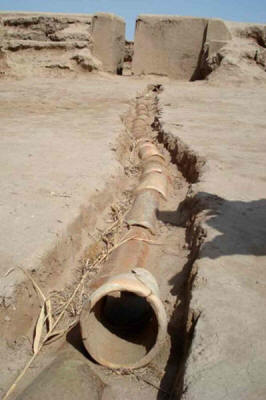 |
| Exposed underground water pipes Photo credits: various samoistina, CAIS, & Eurasianet.org |
Water Management
In addition to the water canals the residents of Gonur had dug from the river to water their fields, the city also had a sophisticated water supply and sewage system.
Water was brought in to the city using underground ceramic pipes with socket (male/female) joints that would have required sophisticated manufacturing and fitting techniques. In the photograph to the right, we see an uncovered pipe for bringing water into a palace-like building.
The city also appears that two separate sewage systems, one for ordinary waste water and the other – it is suggested – for water that had been used for the ritual washing of bodies during funerals.
Święty Jeleń/Muflon/Koziorożec – zwierzę Dziewów (Dewów) zwłaszcza Dziewanny – Skarb z Tillya Tepe, Krąg Bogtoharski – Gonur
Temple
A web article posted by State News Agency of Turkmenistan and quoting Viktor Sarianidi (see below) leader of the excavations, states that in the spring of 2006, his team uncovered a large temple building near the central palace, dated from the late 3rd to the early 2nd millennium BCE.
Other web articles include Discover Magazine, Anahita Gallery, Kar Po’s Travel Blog, Dan & Mary’s Monastery, Archaeology Online, Turkmenistan June 2006 and Stantours. Generally, we find the quality of research and reports available of the web to be less than adequate – poorly researched, highly speculative and sensationalistic.
In reading the articles, we should keep in mind that the early Bronze Age Zoroastrians did not construct temples. This does not mean that the residents of the town did not include Zoroastrians, for it is quite conceivable that Zoroastrians and non-Zoroastrians lived side-by-side.
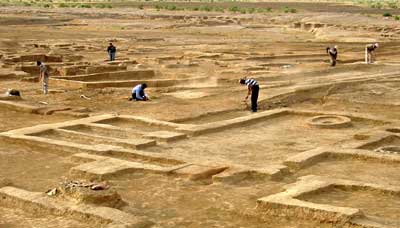 |
| Temple(?) building walls uncovered in Gonur-Depe with three narrow rooms to the left Photo credit: Country Turkmenistan |
State News Agency of Turkmenistan article describes the building uncovered in 2006 as „a monumental building remarkable for the strict geometrical forms and brilliant architectural design. The central part of the shrine which has the walls sometimes 1.5 meters thick and strictly oriented to the sides of horizon is of particular interest. The rooms have the complementary angles. The principles of planning some architectural blocks indicate the specific purposes of using the temple complex. E.g., three single-type corridor-like rooms directly correspond to the architectural design of monumental constructions in the ancient Orient.”
The larger room has a circular foundation (see photograph above) which the article describes as a furnace with an inner and outer chamber. The inner chamber contained burnt material presumably residue of the fuel used but which the article does not identify.
Pots found in the vicinity had an internal lining that made them waterproof, thereby capable of holding liquids.
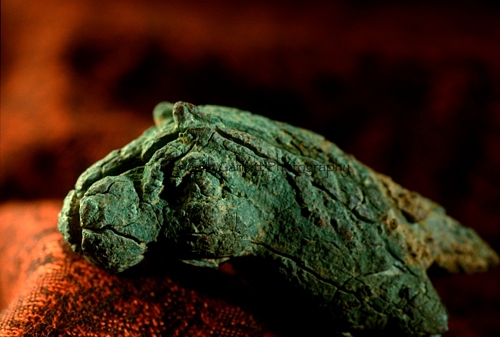 Przepiękna figurka zwirzęca- arcydzieło z Gonur – Motywy zwierzęce i roślinne były jednymi z najważniejszych przedstawień w sztuce Skołotów-Scytów, czyli Słowiano-Indo-Irańczyków
Przepiękna figurka zwirzęca- arcydzieło z Gonur – Motywy zwierzęce i roślinne były jednymi z najważniejszych przedstawień w sztuce Skołotów-Scytów, czyli Słowiano-Indo-Irańczyków
Speculation About the Use of Haoma
The report further states that the archaeologists found evidence that the haoma-like ritual was performed in the building. However, this report is disputed by scientists (Hiebert 1994: 123-129; Parpola 1998: 127;) using more credible analysis techniques (at laboratory of the Helsinki University). Sensationalistic claims by Viktor Sarianidi (see below) of the discover of narcotic material and completely unsubstantiated links with the haoma ritual were found after a more careful study to be implausible.
According to James P. Mallory 1989 & 1997 „… remains of ephedras have also been reported from the temple-fortress complex of Togolok 21 in the Merv oasis (ancient Margiana – Parpola 1988; Meier-Melikyan 1990) along with the remains of poppies. … In 1990 I received some samples from the site [forwarded by Dr. Fred Hiebert of Harvard University], which were subjected to pollen analysis at the Department of Botany, University of Helsinki. …. The largest amount of pollen was found in the bone tube (used for imbibing liquid?) from Gonur 1, but even in this sample, which had been preserved in a comparatively sheltered position when compared with the other investigated samples, only pollen of the family Caryophyllaceae was present. No pollen from ephedras or poppies was found and even the pollen left in the samples showed clear traces of deterioration (typical in ancient pollen having been preserved in a dry environment in contact with oxygen). Our pollen analysis was carefully checked for any methodological errors, but no inaccuracies were found.”
When the careful analysis of the residues in pots did not support Sarianidi claims of the discovery of narcotic substances, the excuse offered is that the vessels are now exposed to the sun and the evidence has been destroyed. Unfortunately, this excuse uncovers yet another problem with Sarianidi excavations – careless exposure of the artefacts and the ruins. Based on this unverifiable claim and quotes from Turkmenistan’s late President-for-life’s personality cult writings, Sarianidi also makes the unsubstantiated claim at Gonur is the birth place of Zoroastrianism. While Zoroastrians could have lived in Gonur – if not elsewhere in the vicinity – there is no basis for this claim.
In any case, it is very doubtful if any temple complex can be associated with Zoroastrians as they did not worship in temples in those days. In addition, if the users of the temple engaged in a haoma-like ritual, the ritual was not the ritual practiced by Zoroastrians.
Necropolis & Burial Customs
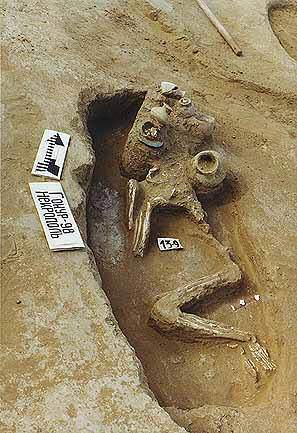 |
| Pit grave in the necropolis Ceramic vessels & a bronze mirror lie next to the skull |
In one section of Gonur North, is a burial site, the necropolis, west of the palace site, containing mostly small children buried in pots. An article by Kate Fitz Gibbon of Anahita Gallery states:
„Their tiny, newborn bones are so fragile that they crumble at a touch. The beautiful Bronze Age beads from plundered sites in Afghanistan have long fascinated me. Most often, buried bead materials are found in vessels placed close to the body, and as any stringing material has long since disintegrated with age, it is not even possible to guess how they were worn. In the Gonur Tepe palace, an unexpected find of a youth buried inside a large ceramic vessel included not only rich grave goods, but also clues as to how some beads were worn. Skull and neck vertebrae were held together with hardened mud, and as the dirt was removed, lapis, talc and a single, inch and a half long carnelian bead carved in chevron patterns were found encircling the neck. A single gold earring was embedded near the ear, and a half-dozen large, finely polished banded agate beads lay in the bottom of the vessel in which the youth was buried.
„My mother and I spent most of our days at Gonur in the large necropolis to the west of the palace site. We used fine brushes to remove the last of the dirt from the whitened bones and grave goods uncovered by the diggers. Each day, three or four grave pits were uncovered and cleared of dirt to the undisturbed earth – about four feet below the present surface. After each day’s excavations at the necropolis, the pits were photographed and partially filled in again. Most skeletons appeared still to lie as they were buried; knees and elbows flexed, the head often resting on or near a small pile of ceramic and stone vessels. It was clear, however, that the necropolis had been robbed in antiquity. Very few items of jewellery were found, and in one grave, a fine, carved alabaster cylinder seal was unearthed under just a few inches of surface soil. A too hasty grave plunderer had apparently dropped it, several thousand years before.”
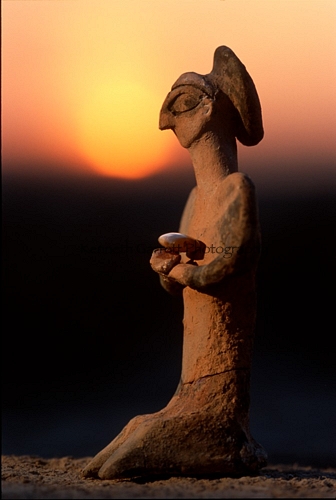 Pierwowzór Matki Pticy – Mati Sławy, czyli Bogini Ptaków, Weny, Słowa i Pogody, albo Czstnoty-Sławuny – Czystoty Sławionej???
Pierwowzór Matki Pticy – Mati Sławy, czyli Bogini Ptaków, Weny, Słowa i Pogody, albo Czstnoty-Sławuny – Czystoty Sławionej???
Gonur Artefacts
The quality, artistry and workmanship of the artefacts unearthed at Gonur has surprised observers. They include intricate jewellery incorporating gold, silver, lapis lazuli, and carnelian. The prowess of the Gonur metalworkers – who used tin alloys and delicate combinations of gold and silver – were on par with the skills of their more famous contemporaries in Egypt, Mesopotamia, and the Indus Valley. Their creations display a rich repertoire of geometric designs, mythic monsters, and other creatures. Among them are striking humanoid statues with small heads and wide skirts, as well as horses, lions, snakes, and scorpions.
Wares in this distinctive style had long been found in regions far and near. As close as Gonur’s southern neighbour Balkh in today’s Afghanistan, and as far as Mesopotamia to the west, the shores of the Persian Gulf to the south, the Russian steppes to the north, and to the southeast across the Hindu Kush – the great cities of Harappa and Mohenjo Daro, which once flourished on the banks of the Indus River in today’s Pakistan. Archaeologists had puzzled over their origin. The Gonur excavations seem to solve the puzzle. These items in the distant lands originated in the region around Gonur and were actively traded by the merchants of Gonur and Central Asia, possible originators of the Silk Roads.
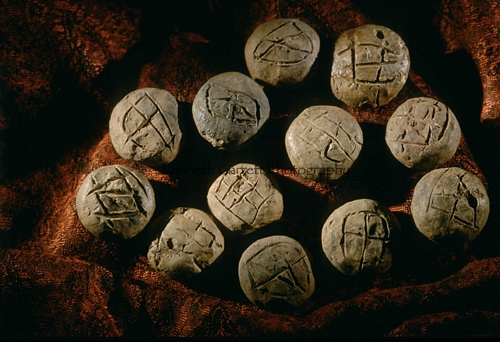 Gonur – znaki pisma na kamieniach
Gonur – znaki pisma na kamieniach
The Abandonment of Gonur
The archaeological record found in Gonur’s ruins lasts for a few hundred years. Archaeologists have not found later artefacts or later layers covering the Bronze Age layer. This has led researchers to surmise that Gonur was abandoned either for reasons of warfare or because of the receding waters of the Murgab, compelling resident to move towards Merv and the surrounding foothills.
In the Avesta’s Vendidad, the virtues associated with the people of Mouru are that they were brave and holy. The evils associated with Mouru are plunder and bloodshed. We do not know if the Mouru engaged in bloodshed and plunder or if they were the victims of plundering aggressors.
The people and nations of the Avesta, the Aryans, were a settled, organized people who farmed and lived in towns. Zoroastrian texts tell us that it is from the north that an ill wind blew and that brought with it a violent and destructive people who raided and plundered the towns of the Aryans.
To the north of the central Asian Aryan kingdoms lay deserts and grazing land inhabited by nomads, a pastoral people who relied on herds that were constantly on the move seeking new pastures. The nomads also hunted for their food and raided the settlements of their neighbours.
There is evidence that extensive fires destroyed some of Gonur’s central buildings – building that they were never rebuilt.
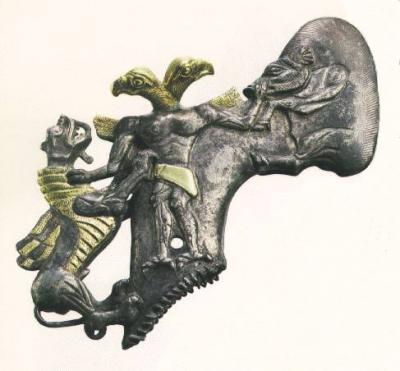 Boski Strasz-Orzeł Dwugłowy Upadający Bóg – pierwowzór rosyjskiego dwugłowego orła herbowego oraz boska Krowa Zemuna i Skrzysty-Skrzydlaty Niebiański Tygrys
Boski Strasz-Orzeł Dwugłowy Upadający Bóg – pierwowzór rosyjskiego dwugłowego orła herbowego oraz boska Krowa Zemuna i Skrzysty-Skrzydlaty Niebiański Tygrys
Kelleli
As with Gonur, Kelleli is a Bronze Age (2500-1200 BCE) settlement located some 40 km northwest of Gonur. The settlement has two major sites: Kelleli 3 and 4. Kelleli 3 is four hectares in size and had double external wall with towers flanking four symmetrical entrances. In the south-western sector, is an area of houses. Kelleli 4 is three hectares in size and also has a double outer wall with towers. According to a UNESCO document, both sites are poorly preserved.
Toguluk / Togulok
|
Togolok consists of two sites, Togolok 1 and Togoluk 21. Togoluk 21 is the larger of the two sites. According to Viktor Sarianidi:
„The next and last shrine excavated is located in the settlement of Togolok 21, which dates to the late 2nd millennium. Taking into account its large overall size (larger than the fortress of South Gonur), it is possible that the shrine of Togolok 21 served the inhabitants of the whole country of Margiana in the late Bronze Age. Similar to the above-described shrines, there is a domestic area near Togolok 21 associated with the shrine. At Gonur depe and Togolok 1 the settlements are many times larger than the shrines, while in Togolok 21 the settlement is a great deal smaller than the shrine itself.
„The shrine of Togolok 21 was built at the top of a small natural hill. Along the outer face of the exterior wall are circular and semicircular hollow towers. In the northern part of the wall are two pylons between which a central gateway, supposed to be the entrance to the shrine, is located. The second entrance was built in the middle of the southern wall. The whole inner area was not built up except at the western side where some extremely narrow rooms are located which appear to have had arched ceilings. Their purpose is unclear. Two altar sites located opposite each other in the northern part of the shrine were perhaps used for carrying out ritual ceremonies associated with libations and fire rituals.”
Adji Kui
Another Bronze Age (2500-1200 BCE) settlement Adji Kui is located about 13 km northwest of Gonur. The present site, Adji Kui 8, is about 8.5 hectares in size.
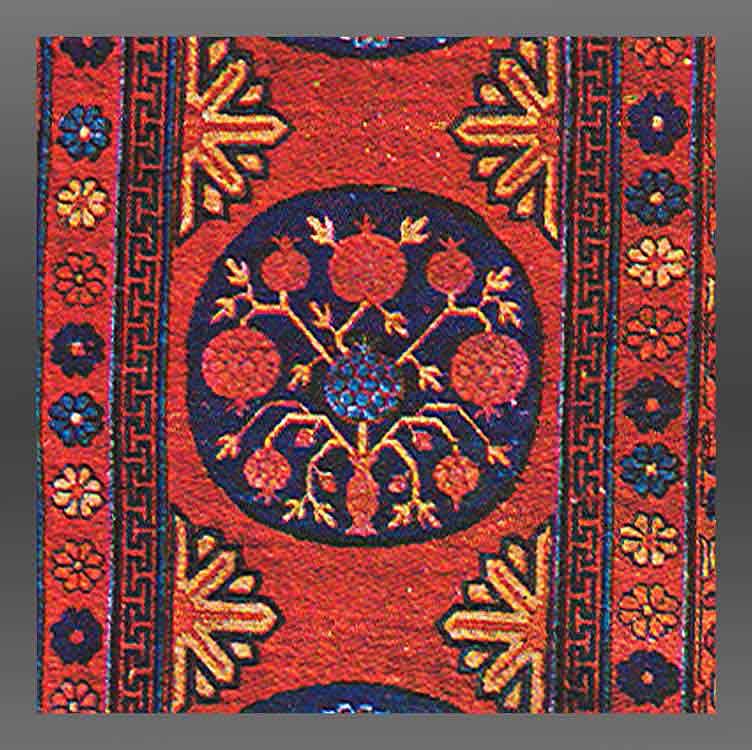 Motyw Drzewa Świata – Karabach – Hotan
Motyw Drzewa Świata – Karabach – Hotan
Taip
The ruins of Taip indicate that the settlement typifies the transition from a Middle Bronze Age form of settlement pattern to a Late Bronze Age settlement. Two close but distinct mounds consist of a 3.5 hectare walled square area with a large courtyard building in the south.
Very Poor Archaeological Practices
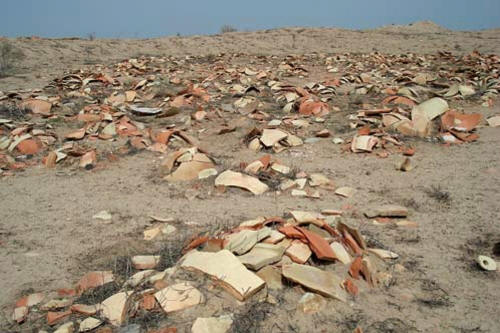 |
| Thousands of pottery shards are scattered across the Gonur-depe excavation site. Visitors steps over these priceless artefacts further destroying a priceless treasure. Photo credit: Eurasianet.org |
The discovery of the ruins in the Merv region may be a mixed blessing. One the one hand the world has become aware of another centre of civilization. On the other hand, the very poor archaeological practices may be the cause of the speedy destruction of the evidence. The following is a quote from Eurasianet.org’s article Turkmenistan: Making a Bid for Cradle-Of-Civilization Status
„In a painful irony, some of the dust that swirls around Gonur-depe comes from the crumbling walls themselves. To study the city, Sarianidi’s team had to remove the protective earthen shield laid down over millennia, thereby exposing the structures beneath to the desert sun and wind. Indeed, today’s photographs of Gonur-depe show a significant deterioration when compared to those of the 1970s and 1980s.”
„Without a greater commitment from the Turkmen state, funding will dry up, the guide said, and Gonur-depe will slowly blow away.”
Research Sites:
» Brief History of Researches in Margiana by Museo-on
Viktor Sarianidi
 |
| Viktor Sarianidi |
For over 30 years, Turkmenistan’s Professor Viktor Sarianidi, Laureate of the Magtymguly International Prize and Doctor of History, has headed the Margiana Archaeological Expedition that has conducted excavations in Turkmenistan and other Central Asian states.
The sites include Namazga-Depe, Altyn-Depe, Delbarjin, the Dashly Oasis, Toholok 21, Gonur, Kelleli, Sapelli, and Djarkutan. In Gonur-Depe for instance, where others saw only sand and scrub, Sarianidi saw the remnants of a wealthy town protected by high walls and battlements. (Indeed all the sites have high protective walls.)
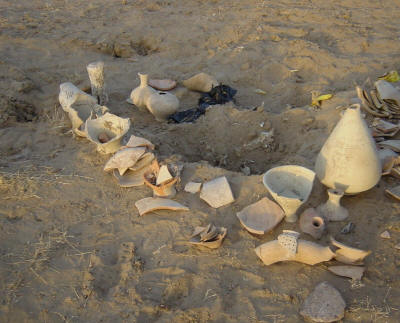 |
| Ancient pottery carelessly strewn all over Sarianidi supervised sites |
While some researchers have applauded Sarianidi for his dedication, others view him as an eccentric, employing brutish and old-fashioned techniques. These days Western archaeologists typically unearth sites with dental instruments and mesh screens, meticulously sifting soil for traces of pollen, seeds, and ceramics. Sarianidi uses bulldozers to expose old foundations, largely ignores botanical finds, and publishes few details on layers, ceramics, and other mainstays of modern archaeology. Ceramics that he has unearthed and which for millennia have remained protected deep in the sand now lie strewn about his sites with visitors stepping over them as they walk around. Local residents and animals also climb all over the fragile earthen structures. His reports are also sensationalistic, conjectural and poorly researched. Sarianidi’s conclusions are routinely contradicted by a more sober analysis. Nevertheless, his findings have provided rich fodder for those captivated by the fantasy generated by his claims. It is unfortunate that his lack of credibility by serious scholars may obscure his other accomplishments. A further tragedy that may overshadow his work is that paradoxically he may have a disservice in unearthing the ruins. The exposed ruins have been left with no protection and are being rapidly eroded.
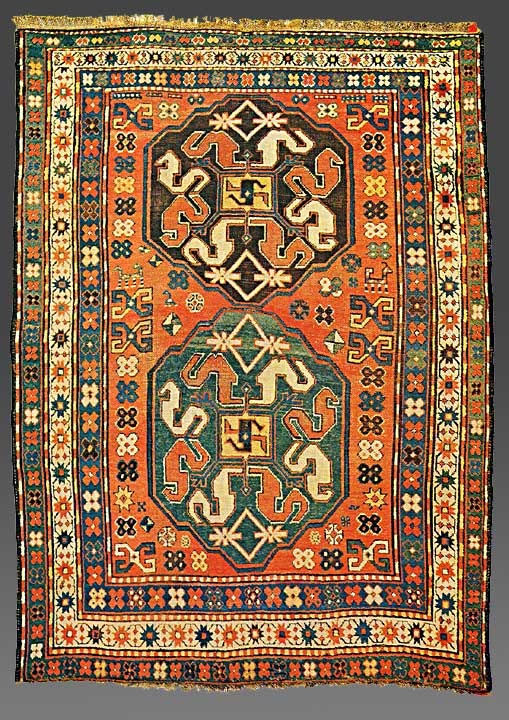 Karabach – motywy słowiańsko-skołockie na dywanie
Karabach – motywy słowiańsko-skołockie na dywanie
As a Greek growing up in Tashkent, Uzbekistan, under Stalinist rule, Sarianidi was denied training in law and turned to history instead. Ultimately, it proved too full of groupthink for his taste, so he opted for archaeology. „It was more free because it was more ancient,” he says. During the 1950s he drifted, spending seasons between digs unemployed. He refused to join the Communist Party, despite the ways it might have helped his career. Eventually, in 1959, his skill and tenacity earned him a coveted position at the Institute of Archaeology in Moscow, but it was years before he was allowed to direct a dig. In 1996, Sarianidi moved to Greece where he currently lives.
BMAC & Andronovo Archaeological Complexes
 |
| Bronze Age Indo-Iranian Archaeological Complexes Image credit: Wikipedia |
In 1976, Viktor Sarianidi proposed that the Bronze Age archaeological sites dating from c. 2200 to 1700 BCE and located in present day Turkmenistan, northern Afghanistan, southern Uzbekistan and western Tajikistan, were the remains of a connected Bronze Age civilization centered on the upper Amu Darya (Oxus). He named the complex the Bactria-Margiana Archaeological Complex (BMAC) and the inhabitants of that period and region, the Oxus civilization.
The name Andronovo complex comes from the village of Andronovo in Siberia where in 1914, several graves were discovered, with skeletons in crouched positions, buried with richly decorated pottery. The name has been used to refer to a set of similar Bronze Age cultures that flourished c. 2300–1000 BCE in western Siberia and the west Asiatic steppes of Kazakhstan. This culture is thought to have been a pastoral people who reared horses, cattle, sheep and goats.
The names of these groupings are those given by archaeologists and have no relation to historical names or one to another. They are better termed as archaeological complexes or archaeological horizons.
There are problems and inconsistencies using these archaeological complexes or archaeological horizons to construct history and anthropological (incorrectly called racial) or cultural connections. The archaeological horizons are the time period in which the groups are believed to have existed are based mainly on pottery and artefact similarities and datings. If no corresponding pottery or artefacts are found after a particular dating, the group is assumed to have disappeared or to have been displaced due to war, famine or disease.
Sarianidi is quoted (as cited in Bryant 2001:207) as saying that „direct archaeological data from Bactria and Margiana show without any shade of doubt that Andronovo tribes penetrated to a minimum extent into Bactria and Margianian oases”.
The following are quotes from the University of Chicago’s page on Archaeology and Language, The Indo-Iranians by C. C. Lamberg-Karlovsky:
„This review of recent archaeological work in Central Asia and Eurasia attempts to trace and date the movements of the Indo-Iranians—speakers of languages of the eastern branch of Proto-Indo-European that later split into the Iranian and Vedic families. Russian and Central Asian scholars working on the contemporary but very different Andronovo and Bactrian Margiana archaeological complexes of the 2d millennium BCE have identified both as Indo-Iranian, and particular sites so identified are being used for nationalist purposes. There is, however, no compelling archaeological evidence that they had a common ancestor or that either is Indo-Iranian. Ethnicity and language are not easily linked with an archaeological signature, and the identity of the Indo-Iranians remains elusive.”
[„C. C. Lamberg-Karlovsky is Stephen Philips Professor of Archaeology in the Department of Anthropology at Harvard University and Curator of Near Eastern Archaeology at Harvard’s Peabody Museum (Cambridge, Mass. 02138, U.S.A.). Born in 1937, he was educated at Dartmouth College (B.A., 1959) and the University of Pennsylvania (M.A., 1964; Ph.D., 1965). His research interests concern the nature of the interaction between the Bronze Age civilizations of the Near East and their contemporary neighbors of the Iranian Plateau, the Indus Valley, the Arabian Peninsula, and Central Asia. His recent publications include Beyond the Tigris and Euphrates Bronze Age Civilizations (Tel Aviv: Ben Gurion University of the Negev Press, 1996) and (with Daniel Potts et al.) Excavations at Tepe Yahya, Iran: Third Millennium (American School of Prehistoric Research Bulletin 42).”]
It is regrettable that through conjecture alone, the Andronovo complex has been connected racially and culturally to the people of the BMAC complex. This error is compounded with the conjecture that the Andronovo complex is connected to the Aryans, misleading some to further believe that the Aryans originated in the Siberian steppes. Because some parts of the Andronovo complex are part of Russian Siberia, in an additional leap of faith, some people have translated the Andronovo region to mean the Russian steppes, leading some to state that the Aryans originated in the Russian steppes, a name that is usually associated with the western Russian steppes – west of the Caspian sea. One error leads to another. There is no credibility to the assertion that the Aryans originated in the Russian steppes.
 Tkanina z Gonur – motywy dobrze mi znane spod Krakowa . Czy Wendidad znaczy Wenedowie? Zdecydowanie tak – pięć Wędodawijskich Plemion
Tkanina z Gonur – motywy dobrze mi znane spod Krakowa . Czy Wendidad znaczy Wenedowie? Zdecydowanie tak – pięć Wędodawijskich Plemion
Nisaya, Nisa – Fifth Vendidad Nation
Nisaim, the fifth nation mentioned in the Vendidad, is identified with the later nations of Nisaya & Nisa. The capital of Nisa was Nisa city. Ancient Nisa was destroyed by an earthquake, which occurred during the first decade BC.
Ruins located near modern-day Bagir village, 18 km southwest of Ashgabat, the capital of Turkmenistan, and alongside the foothills of the Kopet Dag mountains, have been identified as Nisa. The ruins include impressive buildings and fortifications, mausoleums and shrines, inscribed documents, and a treasury robbed of its contents. The artefacts found include art and ivory drinking cups with their outer rims decorated with ancient Iranian classical mythological scenes and themes. The ruins were declared a World Heritage Site by UNESCO in 2007.
Some have identified Nisa with Parthaunisa, the first capital city of the Parthians, prior to its destruction.
The ancient nation of Nisa would have extended along the Kopet Dag mountains in both directions. Its eastern neighbour would have been Mouru. The foothills of the Kopet Dag are scattered with the ruins of an ancient civilization, a fact that did not go unnoticed by Raphael Pumpelly, geologist from New York, in the early 1900s.
Raphael Pumpelly (1837-1923)
Champion of a Central Asian Cradle of Civilization
 |
| Raphael Pumpelly |
More than a century ago an unlikely geologist from New York put forth a proposition that „the fundamentals of civilization – organized village life, agriculture, the domestication of animals, weaving,” (including mining and metal work) „originated in the oases of Central Asia long before the time of Babylon.”
Raphael Pumpelly arrived at this conclusion after visiting Central Asia as a geologist and observing the ruins of cities on the ancient shorelines of huge, dried inland seas. By studying the geology of the area, he became one of the first individuals to investigate how environmental conditions could influence human settlement and culture. Pumpelly speculated that a large inland sea in central Asia might have once supported a sizeable population. He knew from his travels and study that the climate in Central Asia had become drier and drier since the time of the last ice age. As the sea began to shrink, it could have forced these people to move west, bringing civilization to westward and to the rest of the world. He hypothesized that the ruins of cities he saw were evidence of a great ancient civilization that existed when Central Asia was more wet and fertile than it is now.
Such assertions that civilization as we know it originated in Central Asia sounded radical at a time when the names of Egypt and Babylon, regions connected to the Bible, were considered to be the cradle of civilization. But Raphael Pumpelly was persistent. Forty years after his first trip to Central Asia, he convinced the newly established Andrew Carnegie Foundation to fund an expedition. Since the Russians controlled Central Asia, he charmed the authorities in Saint Petersburg into granting him permission for an archaeological excavation. The latter even provided Pumpelly with a private railcar. At the age of 65, Pumpelly was given the opportunity to prove his theory and he wasted no time in starting his work.
Anau
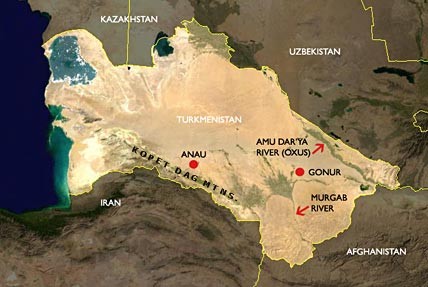 |
| Map showing location of Anau & Kopet Dag Mountains Image credit: Discover Magazine |
On a previous trip, while travelling on Trans-Caspian railway along the foothills of rugged Kopet-Dag mountains which rise up to form the vast Iranian plateau, the three mounds or kurgans at Anau had caught Raphael Pumpelly’s eye.
Anau is a site eight kilometres southeast of Turkmenistan’s Ashgabat modern-day capital, Ashgabat, and its name is derived from Abi-Nau, meaning new water. In earlier times, its name was Gathar.
In the delta around Anau, there are three mounds or kurgans (also called tepe or depe), each containing ruins from a different period. The north mound has layers from the 5th millennium BCE to the 3rd millennium BCE, at which time in history the river Keltechinar appears to have changed course causing a population shift to the south mound that has layers from the mid-3rd millennium BCE to the 1st millennium BCE (the Bronze Age). The east mound has the most recent (medieval to classical period) ruins.
In 1886, a Russian general A. V. Komarov who mistakenly thought the mound was an ancient burial site with treasure worth plundering, had his army brigade cut through the north mound, bisecting the mound. When Pumpelly visited the site in 1903, his training as a geologist enabled him to see twenty stratified occupational layers in this trench. Pumpelly returned to the site in 1904 to start excavations along the Russian trench using sophisticated methods – methods in stark contrast with the plundering dig of the Russians.
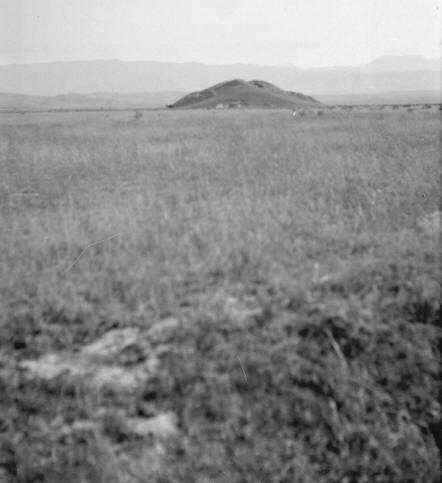 |
| Anau tepe in the distance |
Pumpelly carefully excavated the north mound by digging a series of eight terraces and shafts. He carefully labelled the position of each item he uncovered. He employed fine-scale archaeology methods (methods that are now utilized by modern archaeologists) by using sieves to capture seeds and tiny bones. Then he had specialists, such as botanists and anatomists, analyze his finds. These pioneering methods would only gradually be used by archaeologists over the next century. In the absence of modern methods like radiocarbon dating, Pumpelly used his training as a geologist, keeping careful stratigraphic records to date sites. His findings would come close to matching data collected years later using modern technology and at considerably greater cost.
Pumpelly’s early interest in how humans respond to environmental change is still a keynote feature of archaeology. The kurgan digs unearthed pottery, objects of stone and metal, hearths and cooking utensils – even the remains of skeletons of children found near hearths. He discovered evidence of domesticated animals and cultivated wheat – evidence of the civilization the sought.
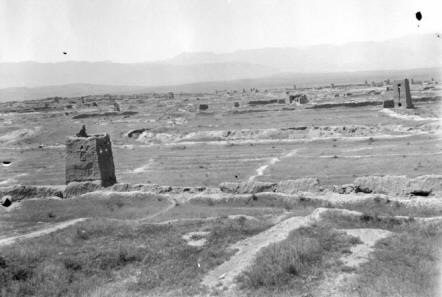 |
| Watch towers along Anau city walls |
Later Pumpelly was to write in his memoirs, „A close watch was kept to save every object, large and small,… and to note its relation to its surroundings. I insisted that every shovelful contained a story if it could be interpreted.” Indeed, every shovelful, even grain, and every shard had a story to tell.
The story of Anau that emerged was one of a planned walled city that was home to a community that farmed wheat, manufactured artefacts and traded with its neighbours.
His work had barely begun, when in 1904 a plague of locusts „filled the trenches faster than they could be shovelled,” and plunged the area into famine, forcing him to abandon the dig, never to return. This phenomenon should not go unnoticed since it might provide clues on the reasons why some settlements appear to have been abandoned in ancient times.
Traveling eastward, he noted the mounds dotting the foothills of the Kopet-Dag, indicating that Anau was not an isolated town, but part of a community of settlements that stretched for a few hundred kilometres, settlements that based themselves on the waters and fertile soil brought down from the mountains. Leaving the mountains, Pumpelly followed the river Murgab north towards the Kara Kum desert. Extreme heat stopped him from exploring the upper reaches of the Murgab delta. Had he done so, he could surely have arrived on the unmistakeable depe mounds of Gonur. That discovery would have to wait for another seventy years and the efforts of a Russian archaeologist of Greek descent, Viktor Sarianidi.
Fredrik Hiebert
Why Pumpelly Remains Unknown
Given Raphael Pumpelly’s extraordinary work and his use of methods that future archaeologists would emulate in years to come, why is it that very few people have ever heard of Pumpelly?
Fredrik Hiebert, an archaeologist with the National Geographic Society and formerly a professor of anthropology at the University of Pennsylvania, who conducted a 1988 dig in the Kara Kum Desert, says that one of the reasons why Pumpelly has been ignored by other archaeologists was their need to defend established theories and resulting bias. In 1904, Mesopotamia, Egypt, and the Mediterranean were the accepted great centres of civilization. „So why in the world would Pumpelly have gone to Turkmenistan to look for civilization? To his peers, it made no sense; people couldn’t comprehend it.”
 |
| American team works at Anau with the the Kopet-Dag mountains in the background Photo credit: Kenneth Garrett at Discover Magazine |
Resumption of Anau Excavations
Hiebert returned to Turkmenistan in 1993 following Turkmenistan’s independence from Russia, this time choosing to work at Anau in collaboration with a Turkmen colleague, Dr. Murad Kurbansakhatov. In 1996, digging in the same kurgan (or tepe / depe meaning mound) Pumpelly had dug in 1904, Hiebert notes: „We dug further down than Pumpelly had been able to do, and what we found was a confirmation of everything he believed.” There was early evidence of civilization in the form of farming – specifically, tiny grains of white wheat, proof, says Hiebert, that the Turkmen people were engaged in agricultural production as early as 6,500 years ago. Hiebert’s wife, a zoo-archaeologist (who joined the dig just as Pumpelly’s wife Eliza had 95 years earlier), discovered bones of domesticated animals. „So here we were, almost 100 years after Raphael Pumpelly had been here, confirming that he was right.”
According to Dr. Hiebert, while Anau is a small site compared to nearby Silk Road sites like Namazga depe and Altyn depe, it none-the-less shows evidence of involvement in a wide-reaching, managed system of distribution and trade occurring at perhaps hundreds of sites throughout the Central Asian Bronze Age period. „This pattern of small and large settlements having elite and bureaucratic functions is unique to the area,” notes Dr. Hiebert.
In his report, Dr. Hiebert stated, „We like Anau because it was occupied for almost every period. Deposits stretch from the earliest village way of life (4500 BCE) to a Bronze Age town (2300 BCE) to a walled classical city (2nd c. BCE) which was eventually topped by a medieval mosque (1500th c CE) with glistening blue-green glazed tiles.”
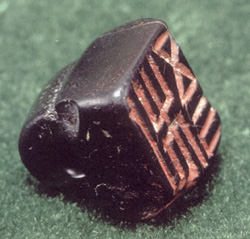 |
| Seal from Anau with unknown markings |
During his excavations, Dr. Hiebert uncovered a unique engraved stamp seal made from a shiny jet-black stone. The seal bore an inscription that was emphasized with a reddish brown pigment. The design of the inscription does not match any known writing or symbol system. Researchers are careful not to claim this is a form of writing, for if it were, it would represent one of the earliest writing systems known. Writes Dr. Hiebert: „Seals are used in the administrative system of an economy that needs to keep track of goods such as supplies for temples, barracks, or palaces.”
 |
| Hiebert excavation unit where seal was discovered |
Dr. Hiebert’s team discovered the stamp seal while excavating at the base of the Bronze Age mound at Anau. There they uncovered the eroded top of a very large, surprisingly well-built building with walls, that even 4300 years later, stand nearly two meters tall. Inside the rooms, archaeologists found the remains of finely made ceramics, some clearly from other regions, as well as and numerous pieces of clay used to seal vessels or parcels.
In 2004, on the occasion of the 100th anniversary conference of Pumpelly’s 1904 Anau dig, Raphael’s great-granddaughter Lisa Pompelli (who uses the original spelling of her family’s Italian surname), accompanied Hiebert and his archaeological team to Turkmenistan to attend the conference and celebrate the opening of that country’s museum devoted entirely to wheat and its early cultivation.
Ancient Kopet Dag Foothill Townships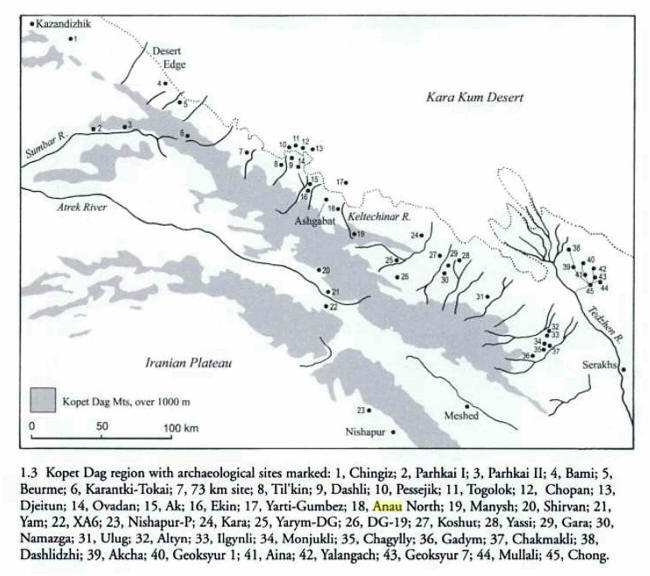
| Archaeological sites along the northern foothills of the Kopet Dag Mountains Image credit: A Central Asian village at the dawn of civilization, excavations at Anau, Turkmenistan by Fredrik Talmage Hiebert, Kakamurad Kurbansakhatov, Hubert Schmidt |
Following the ground breaking excavations and observations of Raphael Pumpelly, discoveries of the settlement of early prehistoric civilizations along the northern foothills of the Kopet Dag mountains are rewriting the history books. This vast archipelago of settlements stretches across 6,000 square kilometres. Modern dating methods date a settlement at Djeitun (not very far from Anau – see site #13 in the map above, #18 being Anau North) at c. 6500 BCE (Ceramic Neolithic period). Two other nearby sites #11. Togolok and #12 Chopan also date back to the early Djeitun period.
A number of the sites, for instance Altyn depe (#32 above and meaning golden hill), contain artefacts from Harappa in the Indus valley and Sumer / Mesopotamia in the Tigris-Euphrates valley indicating extensive and far-reaching trading along the Silk Roads during the Eneolithic Age (between the late 4th and the late 3rd millennia BCE). (cf. Altyn-Depe by Vadim Mikhailovich Masson and Henry N. Michael, Published by Univ. of Pennsylvania Museum of Archaeology.)
If because of climate change, the fertile areas had been receding south towards the mountains, it is reasonable to expect that earlier settlements might have existed in areas that are now part of the dessert. The earliest settlements discovered to this point show well established farming and building techniques. These would not have suddenly manifested themselves but would have taken generations to develop.
In many ways the work of discovering the secrets of the past has only just started. Impeded that war and a changing political environment, the world is only just waking up to the possibility that the Aryan heartland of Central Asia may have an equal claim to being the cradle of civilization.
References:
» Altyn-Depe by Vadim Mikhailovich Masson and Henry N. Michael
» A Central Asian village at the dawn of civilization, excavations at Anau, Turkmenistan by Fredrik Talmage Hiebert, Kakamurad Kurbansakhatov, Hubert Schmidt
 |
| Murgab delta and oasis (circled) in the south of Turkmenistan The Murgab river spreads out and disappears into the Kara Kum desert to the north |
Location
As with Gonur, Merv lies in the Murgab river delta, the area generally considered to be the ancient land of Mouru, the third Vendidad nation.
The ancient city of Merv (Persian Marv), lies 30 km east of the city of Mary (a corrupted form of Merv) capital of the province, or vilayet / welayatlar, of the same name located in south-eastern Turkmenistan bordering Afghanistan. The province has an area of 87,000 square kilometres and a population of 1,146,800 (1995 figures). It is claimed that in medieval times, Merv was the largest city in the world.
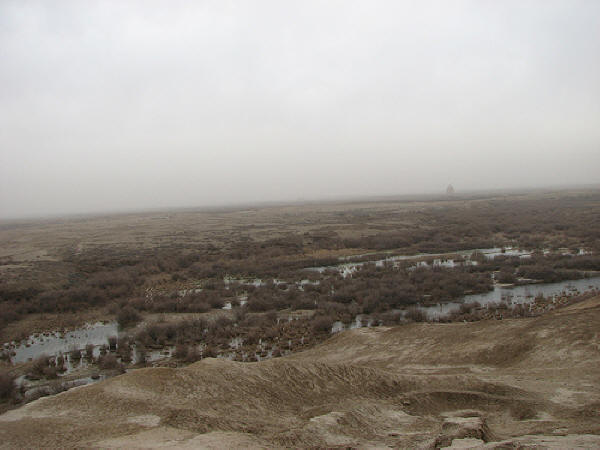 |
| Merv landscape. The site extends past the faint building in the background |
Merv lies on one of the main arms of the ancient Silk Roads that carried trade between Europe and Africa and the Far East. Historically, Merv was also an important departure point for the 180 km journey across desert northwest to ancient Amul (today Turkmenabad) located on the banks of the Amu Darya river. The ruins of ancient Merv are located near the small town of Bairam Ali, a Russian garrison town established in the early twentieth century.
The broad delta of rich alluvial land created by the Murgab river, which flows northwards from Afghanistan, forms an oasis at the southern edge of the Kara Kum Desert.
Endangered Site
In 1987 the Government of Turkmenistan established an archaeological park to protect the sites of the old walled cities, some extra-mural areas, and outlying buildings, thereby protecting the site from agricultural encroachment and improving access to the monuments. In 1999, the United Nations declared Merv a World Heritage Site. Despite these actions, in 2000 the World Monuments Watch placed Merv on its list of the world’s 100 most endangered sites.
History & Cities of Merv
The ruins of Merv contain a succession of ancient cities developed over a period of 2500 years at the heart of the oasis formed by Murgab river delta, and close to the course of where the main river channel flowed in ancient times. Together, the cities of Merv once encompassed over 1200 hectares.
Predating the earliest ruins uncovered so far, Merv was part of the third Avestan nation of Mouru. Unless earlier ruins are discovered, it would appear that Mouru was centered at Gonur, an older city and one that appears to have been abandoned as the residents moved south to the sites of Merv.
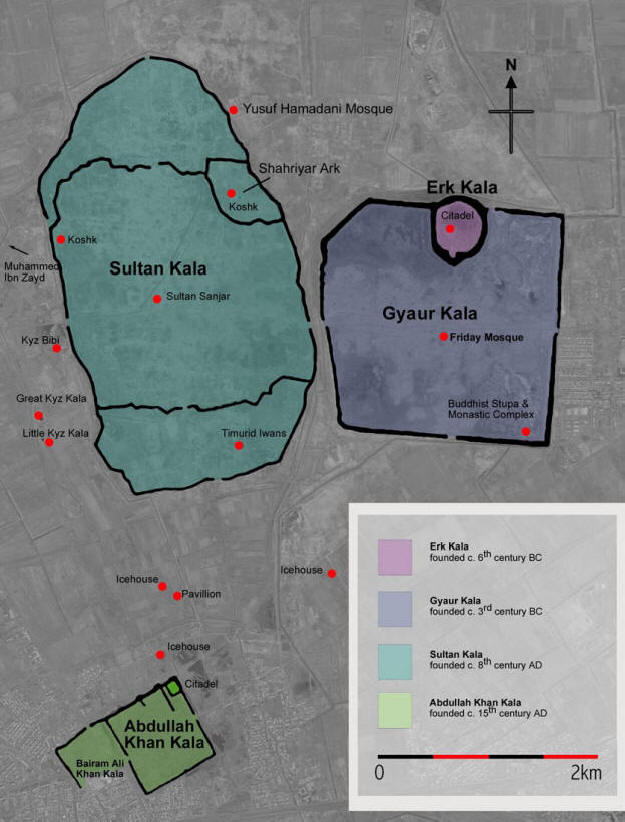 |
| Layout of the Ancient Cities of Merv From: UCL Institute of Archaeology (Home1) (Home2) |
Erk Kala
The oldest of Merv’s ruins, Erk Kala (a modern name meaning citadel castle), date from the 5th century BCE. Constructed by the Persian Achaemenians, Erk Kala appears to have been the central city of Margush as it was known to the Achaemenians serving as an important administrative and trading centre. It lay at the hub of the spectacular Silk Roads along which trade between the furthest reaches of the Persian empire flourished.
The site is some 12 hectares in size and lies 17 metres below today’s surface. Buried under more than 1,500 years of buildings old and new, it is virtually inaccessible to archaeological exploration. Little is therefore known about this enclosure. It is possible that the ruins of an earlier city lie beneath Erk Kala’s ruins.
 |
| Erk Kala |
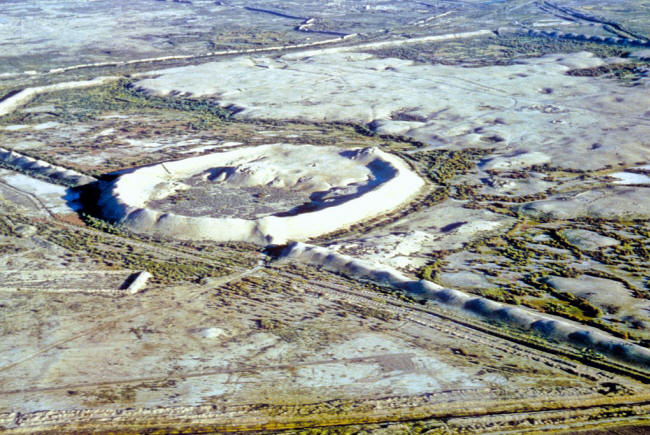 |
| Gyaur Kala with Erk Kala (circular walled structure). Image credit: Wikimedia |
Gyaur Kala
With the defeat of the Achaemenians by Alexander in the 4th century BCE, Merv came under Macedonian rule. After Alexander’s death, the lands he had conquered became the Seleucid Empire ruled, one of his generals Seleucus I (312-280 BCE). Selecus’ successor, Antiochus I (280-261 BCE), began a massive expansion of the city at Merv, constructing a walled city nearly two kilometres across called Antiochia Margiana (today called Gyaur Kala) and covering some 340 hectares. He converted the earlier city of Erk Kala into a citadel that lay within the new walled city. Gyaur Kala was to remain occupied for a thousand years.
The Seleucid dynasty succumbed to the Parthians in c 250 BCE, and the Parthian rule gave way to Sassanian rule in 226 CE. The Parthians and Sassanian continued to maintain Merv’s Gyaur Kala as a major administrative, military and trading centre. The defences were repeatedly rebuilt and strengthened. The vitality of the city during these times is reflected in the wealth of archaeological objects recovered from the excavations within Gyaur Kala. The city did suffer harsh times and destruction during destabilizing migrations and invasions from nomadic tribes. During the 5th century CE, Merv was probably the base for a disastrous Sassanian campaign against the Hephthalite Huns, when many of the Sassanian elite were killed.
 |
| Gyaur Kala in the Sassanian period. Reconstruction drawing by Claire Venables From: UCL Institute of Archaeology |
The Persian Sassanians were defeated by the Arabs in 649 CE. During the rule of the second Arab caliphate, the Umayyads (660 – 750 CE), Merv became the capital of Khorasan (the 'eastern land’) and a centre of further Arab expansion. By the seventh century CE, koshks such as the Kiz Kala or Kyz Kala (see photograph on the page banner at the top of this page), stand alone buildings defended by striking, massive, corrugated walls had been constructed west the city walls.
Persian geographer, traveller and writer, Al-Istakhri (c 951 CE), a wrote that, „For its cleanliness, its good streets, the divisions of its buildings and quarters among the rivers and gardens…, their city (Merv) is superior to the rest of the cities of Khorasan.”
Like Erk Kala, Gyaur Kala also lies buried under a millennium and a half of construction on top of its ruins.
[To the east of Gyaur Kala, the Arabs built a separate walled town, Shaim Kala, to house colonists from over-crowed Basra. Sadly, Shaim Kala has been largely destroyed by a Soviet-planned village. Shaim Kala is not outlined in the satellite image plan above.]
Sultan Kala
By the beginning of the eighth century CE, suburbs had risen near the Majan canal which flowed a kilometre west of Gyaur Kala city wall. When Abbasid Abu Muslim established dynastic power in February 748 CE, he relocated the government buildings and major bazaars from the ancient city to a location near the suburb. Merv prospered at this site under the Abbasids and Tahirids, but went through a period of decline when political power moved to Nishapur and Bukhara.
The Seljuks arrived in the eleventh century CE and revived the city, establishing Merv as their eastern capital and calling it Marv al-Shahijan (today called Sultan Kala). In the process, they built fortification walls around the suburbs, a task that was completed at the end of the eleventh century during the reign of Sultan Malikshah (1072-92 CE).
Sultan Sanjar (1118-57 CE) is credited with construction of a fortified citadel, the Shahriyar Ark, in the northeast corner, and two additional walled suburbs that extended the city to the north and south. The Shahriyar Ark citadel enclosed a palace complex, administrative buildings and residences for the elite.
In 1221 CE, a Mongol army advanced on Merv and its cavalry rode around the walls for spent six days looking for the weak points. The terrified residents negotiated a surrender which only served to open the gates and allow the Mongols to enter, after which they proceeded to massacre the townspeople and burn the town.
The city remained occupied, an impoverished shadow of its former self, until the Timurids integrated the area into their empire in the late 14th century CE.
Skarb Kręgu Gonur – Bogtoharskie złoto z Tillya Tepe – Koziorożec
Abdullah Khan Kala
In the 15th century CE, in preparation for establishing Merv as his capital, Timurid king Shahrukh (1405-47 CE) founded a new planned settlement, now known as the Abdullah Khan Kala, a kilometre south of Sultan Kala. The new town covered some 46 hectares. Shahrukh instituted a major building program, rebuilt the irrigation system, and is credited with construction of the dam at Merv. Construction came to a halt when Shahrukh decided to establish his capital in Samarkand instead. Resumption of development of Merv had to wait until Shaybanis’ reign (1500-98 CE) who built the fortification walls.
In the post-medieval period Merv remained a provincial center, a small town of less than a square kilometre that notwithstanding its diminutive size, boasted, one of the strongest fortification of its time. A mosque, madrasa and reservoir were situated in the center of the northern section, with a citadel in the north corner.
Bairam Ali Khan Kala
A rectangular extension known as Bairam Ali Khan Kala was constructed to the west of Abdullah Khan Kala in the eighteenth century. These two sites were probably in use until the early nineteenth century. By the time the Russians arrived in 1885 CE, the site had been abandoned and many of its buildings had been dismantled to provide bricks for new construction.
Additional reading: UNESCO document no. 886
Skarb Kręgu Gonur – Bogtoharskie złoto z Tillya Tepe – korona księżniczki- kniagini
GONUR DEPE
This is was truly fascinating place but quite difficult to photograph. Said to be the birthplace of Zoroastrianism, Gonur Depe dates from the 3rd millenium BC and was discovered about 20 years ago and is still being excavated. The Bronze Age 'country’ was also known as Margush and Margiana which was also were referred to by Darius I in the 5th century BC. The Margush are considered the „lost fifth civilization”. Personally, I thought it was truly stupendous but I guess you have to be there to really appreciate it.
Bactria–Margiana Archaeological Complex
From Wikipedia, the free encyclopedia
Archaeological cultures associated with Indo-Iranian migrations (after EIEC). The Andronovo, BMAC and Yaz cultures have often been associated with Indo-Iranian migrations. The GGC, Cemetery H, Copper Hoard and PGW cultures are candidates for cultures associated with Indo-Aryan migrations.
The extent of the BMAC (after EIEC).
The Bactria–Margiana Archaeological Complex (or BMAC, also known as the Oxus civilization) is the modern archaeological designation for a Bronze Age culture of Central Asia, dated to ca. 2200–1700 BC, located in present day Turkmenistan, northern Afghanistan and Iran, southern Uzbekistan and western Tajikistan, centered on the upper Amu Darya (Oxus). Its sites were discovered and named by the Soviet archaeologist Viktor Sarianidi (1976). Bactria was the Greek name for the area of Bactra (modern Balkh), in what is now northern Afghanistan, and Margiana was the Greek name for the Persian satrapy of Margu, the capital of which was Merv, in today’s Turkmenistan.
 Pan Żmijów – czyli Czarnogłów – Skarb Kręgu Gonur – Bogtoharskie złoto z Tillya Tepe (niektórzy głupcy wciąż mówią o baktryjskiej Hordzie Nomadów)
Pan Żmijów – czyli Czarnogłów – Skarb Kręgu Gonur – Bogtoharskie złoto z Tillya Tepe (niektórzy głupcy wciąż mówią o baktryjskiej Hordzie Nomadów)
Overview
Sarianidi’s excavations from the late 1970s onward revealed numerous monumental structures in many different sites, including Namazga-Depe („governmental centre”), Altyn-Depe („secondary capital”), Delbarjin, the Dashly Oasis, Toholok 21, Gonur, Kelleli, Sapelli, and Djarkutan. The sites were fortified by impressive walls and gates. Reports on the BMAC were mostly confined to Soviet journals until the last years of the Soviet Union, so the findings were largely unknown to the West until Sarianidi’s work began to be translated in the 1990s.
Scholars do not agree on either the origins of the Bactria-Margiana complex, or the reasons for its decline. Its distinctive material culture disappears from the archaeological record a few centuries after it appears.[1] Radiocarbon dating suggests dating the complex to the last century of the 3rd millennium and the first quarter of the 2nd millennium BC.
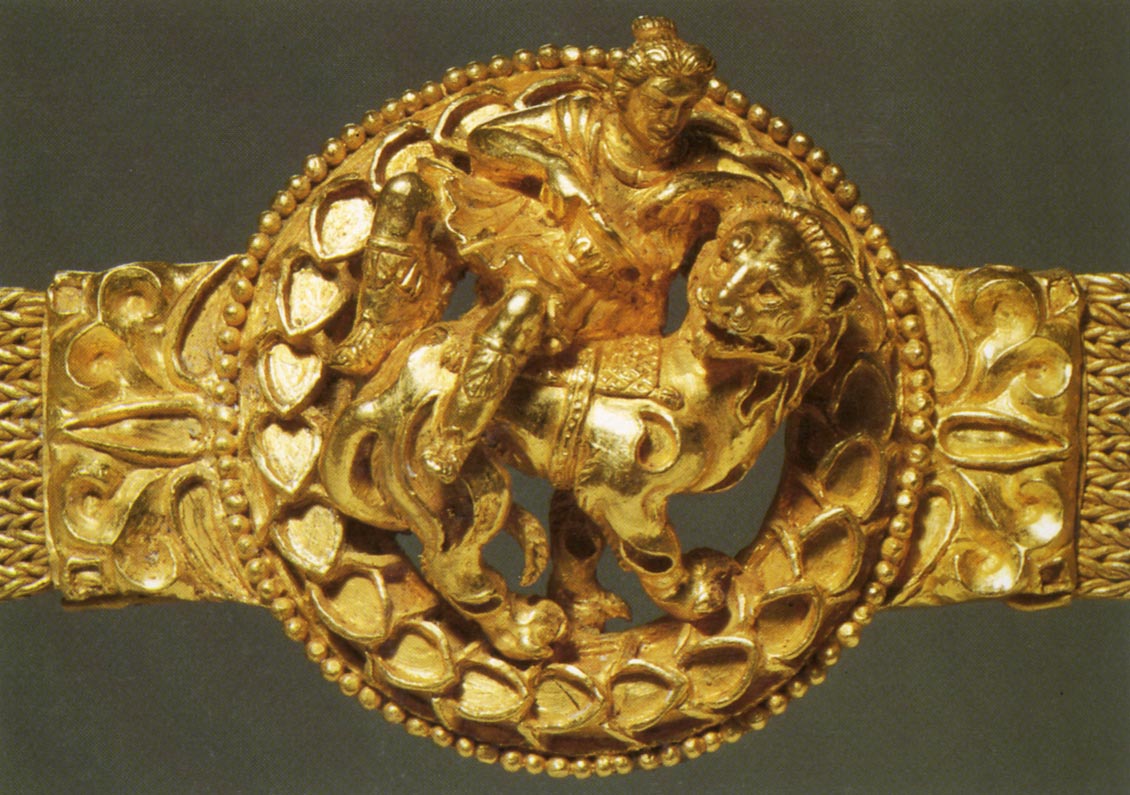 Skarb Kręgu Gonur – Bogtoharskie złoto z Tillya Tepe – ozdoba pasa
Skarb Kręgu Gonur – Bogtoharskie złoto z Tillya Tepe – ozdoba pasa
Geographically, the Bactria-Margiana complex spans a wide area from southeastern Iran to Balochistan and Afghanistan. Possibly the archaeologically unexplored terrain of Baluchistan and Afghanistan holds the heartland of the complex (see Lamberg-Karlovsky 2002).
BMAC materials such as seals have been found in the Indus civilisation, on the Iranian plateau, and in the Persian Gulf. BMAC finds are coming onto the international trade in illicit antiquities and are finding their way into Western collections and museums.
Skarb Kręgu Gonur – Bogtoharskie złoto z Tillya Tepe (niektórzy głupcy wciąż mówią o baktryjskiej Hordzie Nomadów) – Dziewanna z Tillya Tepe (właściwie Atena – z Grecji, ale w tymże skarbie z tillia Tepe)
A previously unknown civilization?
The inhabitants of the BMAC were sedentary people who practised irrigation farming of wheat and barley. There has been interaction with the nomadic people of the contemporary Andronovo culture of the steppe to the north, as the findings of steppe pottery in the BMAC indicate. With their impressive material culture including monumental architecture, bronze tools, ceramics, and jewellery of semiprecious stones, the complex exhibits many of the hallmarks of civilization.
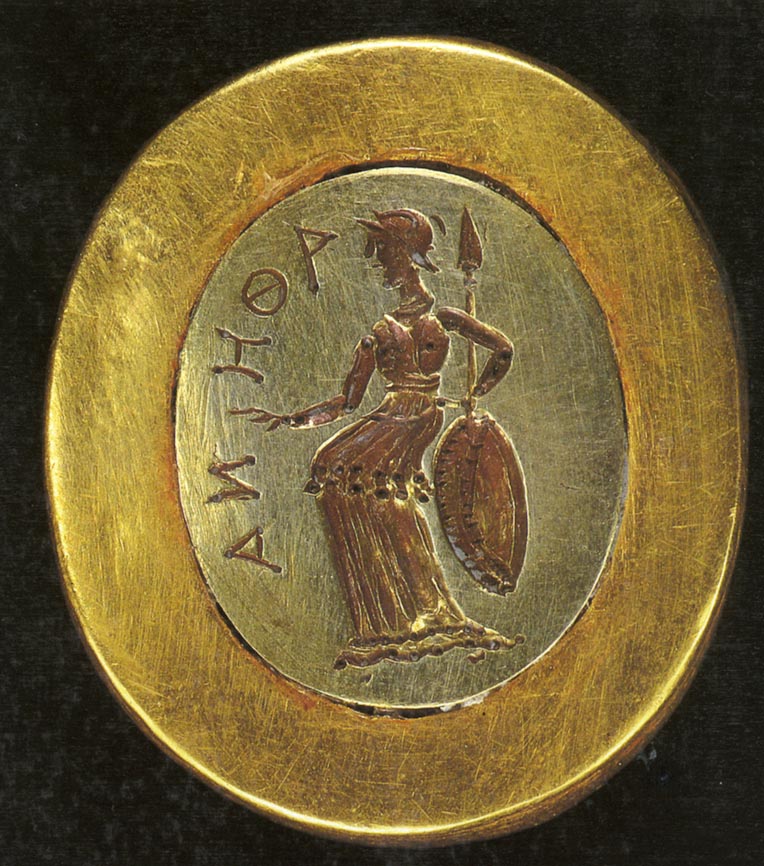 Skarb z Tillia Tepe – Atena (wyrób grecki-romajski)
Skarb z Tillia Tepe – Atena (wyrób grecki-romajski)
The discovery of a single tiny stone seal with geometric markings from a BMAC site in Turkmenistan in 2001 led some to claim that the Bactria-Margiana complex had also developed writing, and thus may indeed be considered a literate civilization. It is not clear however if the markings represent a true writing system as opposed to isolated pictographs.V. Mair (2001) has shown that the Chinese-like signs are indeed parallel to Chinese inscriptions used some 2500 [when?] [vague] [dubious – discuss] years later in Xinjiang. The tiny seal has been dislocated down from its original, much later layer. Nevertheless, the BMAC seals contain motifs and even material that are distinctive from seals of Syro-Anatolia, Mesopotamia, the Persian Gulf, showing they form a type not derived from any other region.
Skarb Kręgu Gonur – Bogtoharskie złoto z Tillya Tepe -naszyjnik
The Indo-Iranian hypothesis
Golden bull’s head from Altyn-Depe.
The Bactria-Margiana complex has also attracted attention as a candidate for those looking for the material counterparts to the Indo-Iranians, a major branch that split off from the Proto-Indo-Europeans. Sarianidi himself advocates identifying the complex as Indo-Iranian, going as far as to identify evidence of proto-Zoroastrian objects and rituals. James P. Mallory argues
„The geographic location of the BMAC … conforms, it is argued, with the historical situation of the Da(h)a and Parnoi mentioned in Greek and Latin sources, which have, in turn, been identified with the Dasas, Dasyus, and Panis of the Rig Veda who were defeated by the Vedic Arya.” –EIEC, p. 73.
Similarly, he argues that the design of the BMAC forts „matches the description of the fortified sites depicted in the Vedas”[2] and mentions evidence for the presence of the soma-cult. The alleged findings of ephedra stems in BMAC context have however been disproved (Bakels 2003).
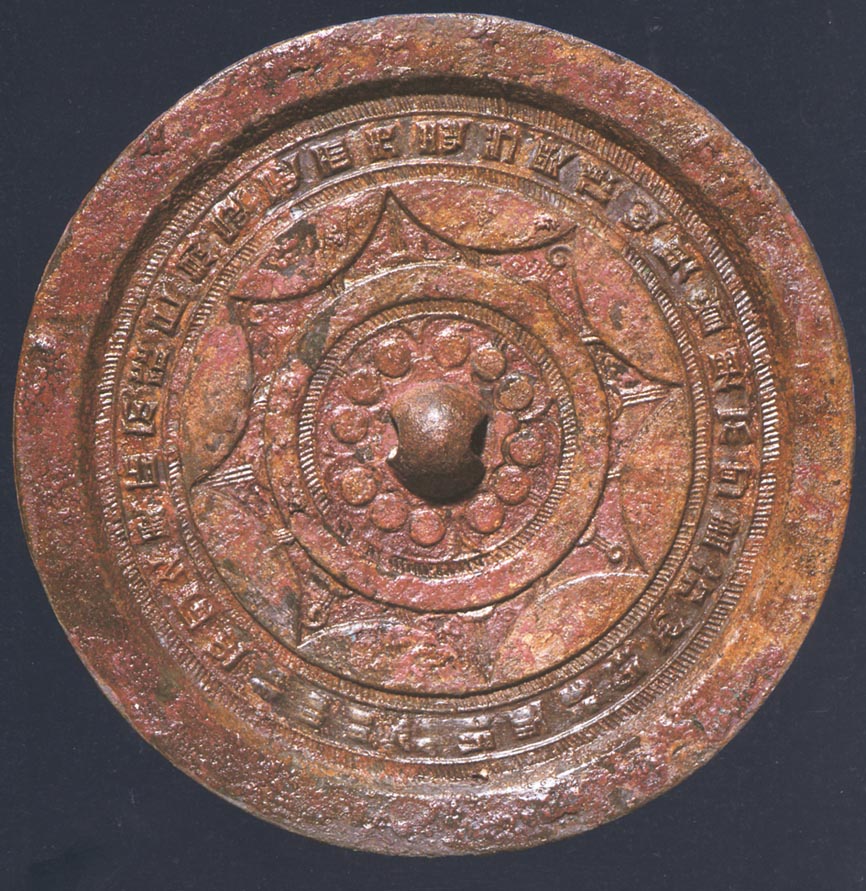 Skarb z Tillia Tepe – znalezisko ekspedycji Wiktora Sarianidiego – chińskie lustro
Skarb z Tillia Tepe – znalezisko ekspedycji Wiktora Sarianidiego – chińskie lustro
Others maintain there is insufficient evidence for any ethnic or linguistic identification of the BMAC solely based on material remains, in the absence of written records. The archaeological record is inconclusive with regard to a migration of Indo-Aryans or Indo-Iranians to the BMAC[3], or with a migration of Indo-Aryans from the BMAC to the Indus Valley.[4] There is no archaeological evidence for an invasion into Bactria and Margiana.[5] Furthermore, there is no evidence that the complex even represented an ethnic/linguistic unity. Moreover, cultural links between the BMAC and the Indus Valley can also be explained by reciprocal cultural influences uniting the two cultures, or by the transfer of luxury or commercial goods.[6]
The BMAC complex is also very poor in horse remains or representations, which are often seen as a sign for Indo-Aryan presence.[7]
The Indo-Iranian substratum
Altyn-Depe location on the modern Middle East map as well as location of other Eneolithic cultures (Harappa and Mohenjo-daro).
As argued by Michael Witzel (1999) [1], (2003) [2] and Alexander Lubotsky[8], there is a pre-Indo-European substratum in proto-Indo-Iranian which can be more plausibly identified with the original language (or languages) of the BMAC, which was, then, eventually given up by the locals in favour of proto-Indo-Iranian.
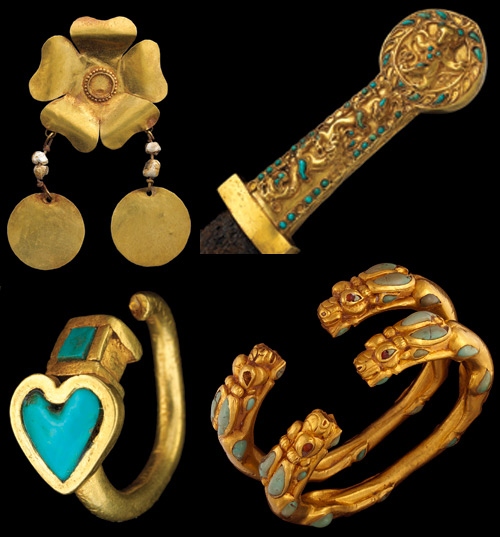 Skarb Kręgu Gonur – Bogtoharskie złoto z Tillya Tepe (niektórzy głupcy wciąż mówią o baktryjskiej Hordzie Nomadów)
Skarb Kręgu Gonur – Bogtoharskie złoto z Tillya Tepe (niektórzy głupcy wciąż mówią o baktryjskiej Hordzie Nomadów)
Moreover, he points out a number of words apparently borrowed from the same language, which, however, are only attested in Indic. Provided this is not an accident of attestation, it may mean that the area where the language (or language family) in question was spoken included at least Gandhara as well, if not the Indus Valley also. This would fit the archaeological evidence mentioned above, pointing to a connection of the BMAC to these areas. Considering that the BMAC is suspected to extend into Afghanistan and Baluchistan (see above), these areas may be included as well. The assumed Indo-Iranian substratum, then, is potentially relevant to the question about the language of the Indus Valley Civilization, as well. However, some BMAC words have now also been found in Tocharian (G. Pinault 2003), which renders a widespread BMAC language, from Xinjiang to the Panjab, unlikely and points to cultural influence. This, however, suggests the possibility that the language in question was spoken natively in a more limited area (such as the BMAC), but used in a larger area as a lingua franca, considering the fact that the evidence is exclusively in the form of loanwords rather than grammatical or phonetic structures. Hence, it would originally have functioned as a superstrate language.[9]
As to known languages which might be related to the Indo-Iranian substratum, the most obvious candidate, geography considered, is the Burushaski language[10].
Skarb Kręgu Gonur – Bogtoharskie złoto z Tillya Tepe (niektórzy głupcy wciąż mówią o baktryjskiej Hordzie Nomadów)
Sites
- Altyndepe
- Namazga-Tepe
- Jeitun
- Gunar Tepe
- Togolok 21
- Koi Krylgan Kala
- Toprak Kala
- Ayaz Kala
Skarb Kręgu Gonur – Bogtoharskie złoto z Tillya Tepe (niektórzy głupcy wciąż mówią o baktryjskiej Hordzie Nomadów) – Człowiek jadący rydwanem
Notes
- ^ „the settlements of this culture are characterized by a very feeble accumulation: they were constructed in haste, apparently on the basis of a pre-established plan, and have not been occupied for very long” Bernard Sergent. Genèse de l’Inde. 1997, quoted from Elst 1999
- ^ Lyonnet (1993) and Sethna (1992) have noted that only one circular fort with three walls has been discovered (Dashly-3), or that the circular walls had no value of defence (Jettmar 1981). See Bryant 2001:220
- ^ Francfort H.-P. in Fussman, G.; Kellens, J.; Francfort, H.-P.; Tremblay, X. 2005
- ^ Bryant 2001; Francfort H.-P. in Fussman, G.; Kellens, J.; Francfort, H.-P.; Tremblay, X. 2005
- ^ Bryant 2001:220 (quotes Lyonnet 1993 and Parpola 1993); Fussman, G.; Kellens, J.; Francfort, H.-P.; Tremblay, X. 2005
- ^ e.g. Fussman, G.; Kellens, J.; Francfort, H.-P.; Tremblay, X. 2005; Bryant 2001:215-16
- ^ Bryant 2001
- ^ The Indo-Iranian Substratum
- ^ Sarah Thomason and Terence Kaufman, Language Contact, Creolization and Genetic Linguistics (University of California Press 1988)
- ^ compare an essay by Michael Witzel, page 6, note 11.
Odwzorowanie układu Gonur na tkaninach tradycyjnych z Turkmenii – Skarby Gonuru
References
- Sarianidi, V. I. 1976. „Issledovanija pamjatnikov Dashlyiskogo Oazisa,” in Drevnii Baktria, vol. 1. Moscow: Akademia Nauk.
- Lamberg-Karlovsky, C. C. 2002. „Archaeology and Language: The Indo-Iranians,” in Current Anthropology, vol. 43, no. 1, Feb. year University of Chicago
 Gonur oryginalny układ grodu i swiątyni
Gonur oryginalny układ grodu i swiątyni
Further reading
- Edwin Bryant (2001). The Quest for the Origins of Vedic Culture: The Indo-Aryan Migration Debate. Oxford University Press. ISBN 0195169476.
- CNRS, L’archéologie de la Bactriane ancienne. Paris: Editions du Centre National de la Recherche Scientifique, 1985
- Fussman, G.; et al. (2005). Aryas, Aryens et Iraniens en Asie Centrale. Paris: de Boccard. ISBN 2868030726.
- Mallory, J. P. (1997). „BMAC”. Encyclopedia of Indo-European Culture. London: Fitzroy Dearborn. ISBN 1884964982.
- Lubotsky, A. (2001). „Indo-Iranian substratum”. in Carpelan, Christian. Early Contacts between Uralic and Indo-European. Helsinki: Suomalais-Ugrilainen Seura. ISBN 9525150593. http://www.ieed.nl/lubotsky/pdf/Indo-Iranian%20substratum.pdf.
- Sarianidi, V. I. (1994). „Preface”. in Hiebert, F. T.. Origins of the Bronze Age Oasis Civilization of Central Asia. Cambridge: Harvard University Press. ISBN 0873655451.
- Sarianidi, V. I. (1995). „Soviet Excavations in Bactria: The Bronze Age”. in Ligabue, G.; Salvatori, S.. Bactria: An ancient oasis civilization from the sands of Afghanistan. Venice: Erizzo. ISBN 8870770257.
- Forizs, L. Apâm. Napât, Dîrghatamas and the Construction of the Brick Altar. Analysis of RV 1.143 (pdf, 386 kB), paper read at the Vedic Panel of the 12th World Sanskrit Conference, Motilal Banarsidass, 2007 (in preparation)
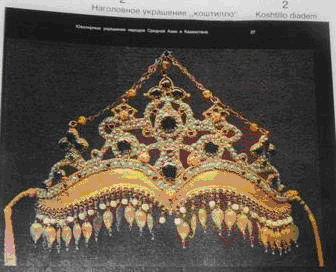 Bogtoharskie skarby z Kręgu Gonuru – Skarb z Tillya Tepe, Afgańskie odkrycie Wiktora Sarianidiego (niektórzy głupcy wciąż mówią o baktryjskiej Hordzie Nomadów) – Kabłączek skroniowy, ozdoba rozpowszechniona także wśród Słowian wszystkich możliwych kultur archeologicznych
Bogtoharskie skarby z Kręgu Gonuru – Skarb z Tillya Tepe, Afgańskie odkrycie Wiktora Sarianidiego (niektórzy głupcy wciąż mówią o baktryjskiej Hordzie Nomadów) – Kabłączek skroniowy, ozdoba rozpowszechniona także wśród Słowian wszystkich możliwych kultur archeologicznych
Tillya Tepe
Tillya tepe, Tillia tepe or Tillā tapa ( Pashto and Persian: طلا تپه) or (literally „Golden Hill” or „Golden Mound”) is an archaeological site in northern Afghanistan near Sheberghan, surveyed in 1979 by a Soviet-Afghan mission of archaeologists led by Victor Sarianidi, a year before the Soviet invasion of Afghanistan.
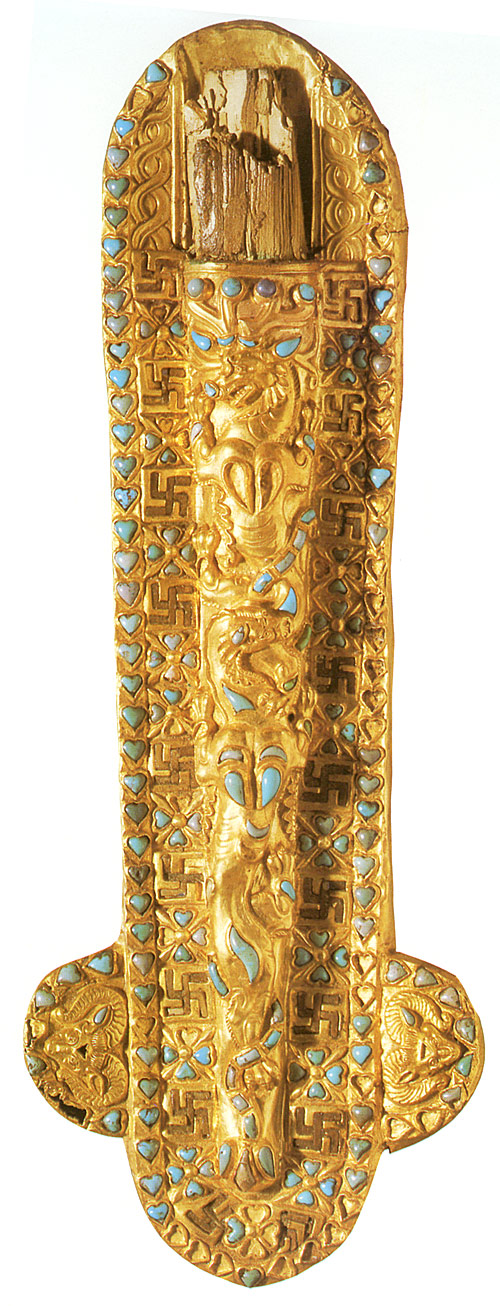 Skarb Kręgu Gonur – Bogtoharskie złoto z Tillya Tepe – Sztylet zdobiony w swastyki i żmije-smoki. Takie same sztylety znajdowano w grobach Sarmatów europejskich.
Skarb Kręgu Gonur – Bogtoharskie złoto z Tillya Tepe – Sztylet zdobiony w swastyki i żmije-smoki. Takie same sztylety znajdowano w grobach Sarmatów europejskich.
The heavily fortified town of Yemshi-tepe, just five kilometres to the northeast of modern Sheberghan on the road to Akcha, is only half a kilometre from the now-famous necropolis of Tillia-tepe.
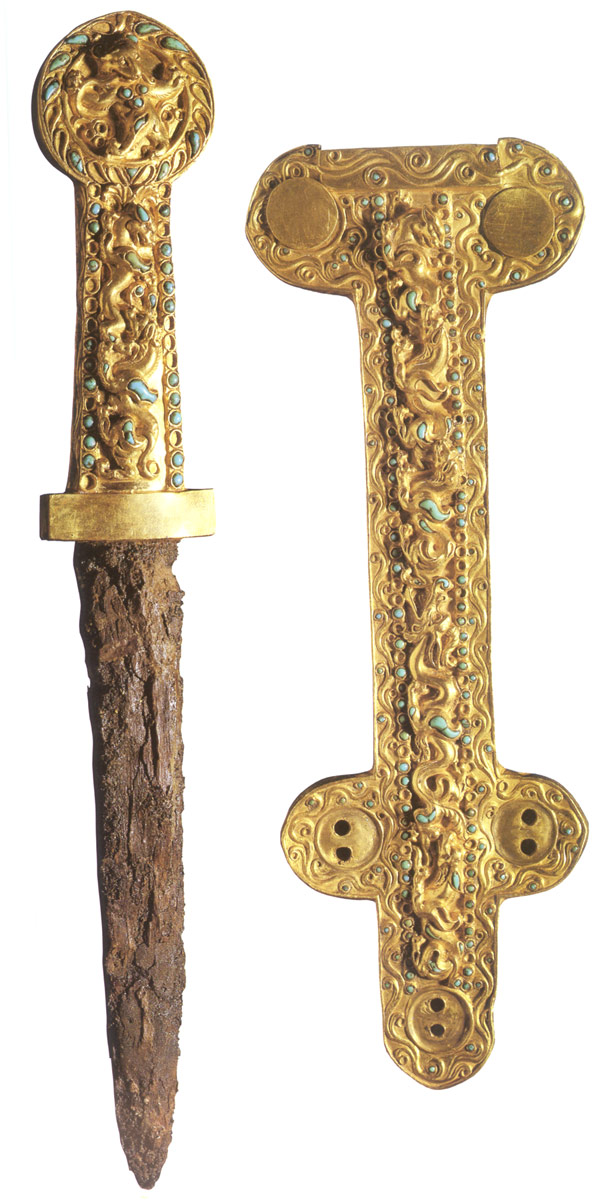 Skarb Kręgu Gonur – Bogtoharskie złoto z Tillya Tepe – Sarmacki sztylet i pochwa
Skarb Kręgu Gonur – Bogtoharskie złoto z Tillya Tepe – Sarmacki sztylet i pochwa
The hoard is a collection of about 20,000 gold ornaments that were found in six graves (five women and one man) with extremely rich jewelry, dated to around the 1st century BCE. Altogether several thousand pieces of fine jewelry were recovered, usually made of gold, turquoise and/or lapis-lazuli. The ornaments include coins, necklaces set with gems, belts, medallions and crowns. A new museum in Kabul is being planned where the Bactrian gold will eventually be kept.
Some of the most spectacular finds were on display until Sept. 7th, 2008 at the National Gallery of Art, Washington, D.C. From Oct. 24th, 2008 to Jan. 25th, 2009 the collection was at the Asian Art Museum of San Francisco. From there they were to be displayed from February 22 to May 17, 2009 at The Museum of Fine Arts, Houston and then the Metropolitan Museum of Art, New York from June 23 to Sept. 20th, 2009.
Inny sarmacki sztylet z Rosji europejskiej
Dates and context
Several coins dated up to the early 1st century CE, with none dated later, suggest a 1st century CE date for the burial. The burial could correspond to Scythian or Parthian tribes dwelling in the area, or may correspond to the extinction of the local Yuezhi royal dynasty after the conquests of all the other xihou or 'princes’ in Daxia by Kujula Kadphises. (See Pre-Islamic period of Afghanistan.)

A silver coin was found from the reigns of the Parthian king Mithridates II, who ruled c. 123–88 BCE. The coin was found in tomb III, and was apparently held in the hand of the defunct woman.
An imitation gold coin of Parthian King Gotarzes I (95-90 BCE) was found in the left hand of the defunct woman in tomb 6. The fact that this coin is in gold, and not silver or bronze as is usually the case for Parthian coinage, suggest that this imitation was made for prestige purposes. The coin is counterstamped with the frontal depiction of what might have been a local chieftain. The counterstamp was added so as to not damage the portrait of the Parthian king, perhaps indicating some degree of dependency on the Parthians.
A gold coin was also found in tomb III showing the bust in profile of the wreath-crowned Roman Emperor Tiberius. On the reverse is an enthroned, sumptuously draped female figure holding a spray and scepter. Coins of this type were minted in the city of Lugdunum in Gaul, between 16 and 21 CE.[1]
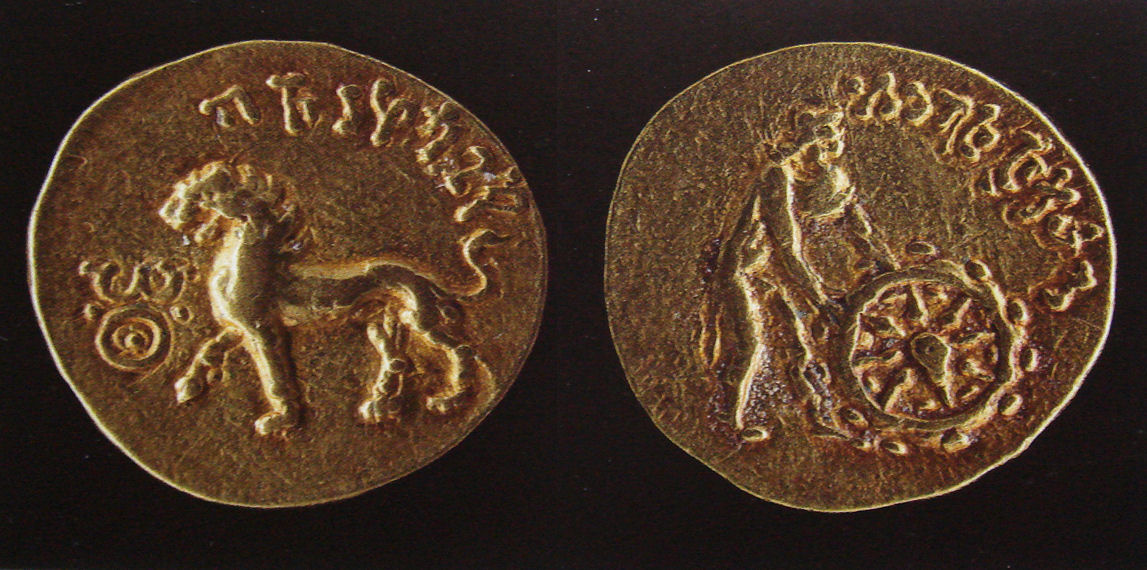 Skarb Kręgu Gonur – Bogtoharskie złoto z Tillya Tepe
Skarb Kręgu Gonur – Bogtoharskie złoto z Tillya Tepe
A Buddhist gold coin from India was also found in tomb IV (the male warrior). On the reverse, it depicts a lion with a nandipada, with the Kharoshthi legend „Sih[o] vigatabhay[o]” („The lion who dispelled fear”). On the obverse, an almost naked man only wearing an Hellenistic chlamys and a petasus hat (an iconography similar to that of Hermes/ Mercury) rolls a wheel. The legend in Kharoshthi reads „Dharmacakrapravata[ko]” („The one who turned the Wheel of the Law”). It has been suggested that this may be an early representation of the Zoroaster.[5]
Finally, a very worn coin has been identified as belonging to the Yuezhi chieftain Heraios.
Rekonstrukcja – skarb Kręgu Gonur – Bogtoharskie złoto z Tillya Tepe
It is thought that the site belonged to Sakas (Asian Scythians, who were later to migrate to India, where they are known as Indo-Scythians), although some suggest the Yuezhi (future Kushans) or eastern Parthians as an alternative. Several of the artifacts are highly consistent with a Scythian origin, such as the royal crown or the polylobed decorated daggers discovered in the tombs. Several of the defuncts exhibited ritual deformation of the skull, a practice which is well documented among Central Asian nomads of the period.
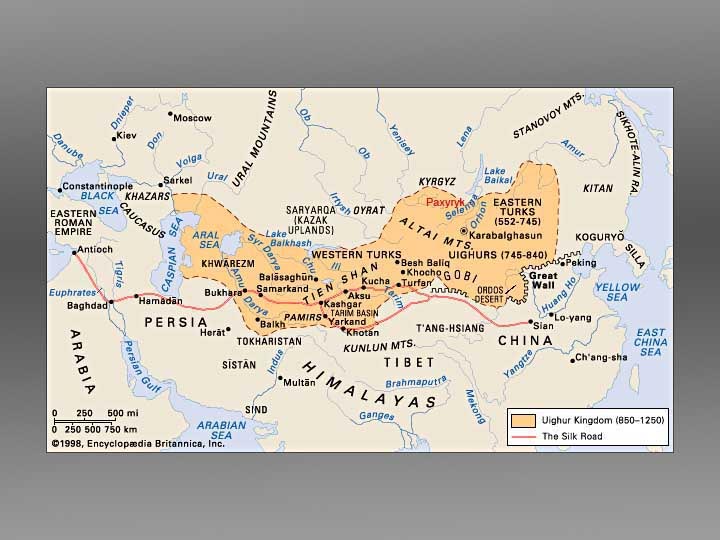 Mapa z okresu znacznie późniejszego – Władztwo Ujgurów znanych nam dzisiaj z rozruchów w Chinach, bo tam sięgała Haria Toki Maha (Maga) Wielkiego (850 – 1250 n.e.)
Mapa z okresu znacznie późniejszego – Władztwo Ujgurów znanych nam dzisiaj z rozruchów w Chinach, bo tam sięgała Haria Toki Maha (Maga) Wielkiego (850 – 1250 n.e.)
Gonur Tepe: A Visit to Bronze Age Turkmenistan
| Bronze belt stud, 2200-1800 BC, Northern Afghanistan Bronze Age, depicting a winged female figure poised between two griffins.A pit grave in the necropolis. Ceramic vessels and a bronze mirror lie next to the skull. Afghanistan Bronze Age Talc head of a composite statue.Turkoman archeologist T. Khojanijazoff at work at Gonur North. Russian archeologist Victor Sarianidi plays at backgammon with a local Turkoman farmer under the meal tent.Jane and Kate Fitz Gibbon and Aq Kiz, displaying her embroidery work. Aq Kiz, a Tekke Turkoman wizard of a cook, made fine soups, complex stuffed breads and even crepes with camel’s cream – all on a single gas burner, working without refrigerator or ready access to supplies. Aq Kiz’s brother Muhammad prepares the fire pit for roasting a lamb.Gonur Tepe – A Visit to Bronze Age Turkmenistan
Only in the last quarter century, has the culture of Bronze Age Central Asia become widely known in the West. Since 1972, the work of excavation and analysis of this contemporary of the Mesopotamian and Indus Valley civilizations has in large part been accomplished by the Margianan Archeological Expedition, directed today by the Russian archeologist Victor Sarianidi. Dr. Sarianidi’s recent work has focused on the Late Bronze Age sites, dating to the first half of the second millennium BC, located in the ancient delta of the Murgab River, in the southeastern part of present day Turkmenistan. Gonur Tepe was the largest of dozens of scattered Bronze Age sites established here in the early second millennium. Gonur appears to have served as an administrative and religious center for the region, and as a hub for long distance trade. Its sophisticated, monumental architecture, and elegant material remains in art and ornament indicate the high culture achieved before a variety of factors led to the movement of its peoples further south and east. A recent trip to the site brought Kate and Jane Fitz Gibbon first to Ashkabad, capital of Turkmenistan, then five hours northeast by paved road to Mary, and finally, across the open desert in an antique Russian military vehicle It is evening, and a Greek popular song reeds from a cheap cassette. The mud-brick guest house, the shower hut and even the distant, low walls of the Gents and Ladies outhouses are framed and tipped with gold by the setting sun. Rough laughter sounds from the tents of the Turkoman diggers as they prepare their evening meal. The youngest haul water in buckets from an aging Russian tanker. The older men show off their cooking skills, and tease the young ones about the brides they hope to earn with their digger’s wages. We are deep in the Karakum Desert, 70 kilometers from ancient Merv, and even further from the boys’ homes in Mary and its surrounding villages. Russian archeologist Victor Sarianidi’s camp is so far from settled lands that we see no one but an occasional herdsman with his flock, or a roaming Bactrian camel, yet we are within fifteen minutes walk of three important sites of the ancient Bronze Age. To the east is the low hill that holds Gonur North, an enormous palace and administrative center. The bulldozer will work all night under generator lights to clear away the dirt hauled to the surface today. Gonur North grows every day under the digger’s shovels, and there are indications that still another set of buildings lies eastward of the main walls. Four thousand years ago, this was a rich trading center and the seat of kings. Though all that remains are its baked brick walls, it is easy to identify the large halls where rulers may have held audience; these are wide portaled, elegantly proportioned rooms. In one especially large one there are voids in the corners and along the walls where stood columns or statues of wood that have long since rotted away. My mother and I are drawn here again and again, wandering through the rooms, trying to make sense of their arrangement, to piece together this ancient puzzle. Here our „job” – preparing the finds for photography, brushing the dirt gently from skeletons unearthed by the diggers – is difficult, for we find mostly small children buried in pots. Their tiny, newborn bones are so fragile that they crumble at a touch. The beautiful Bronze Age beads from plundered sites in Afghanistan have long fascinated me. Most often, buried bead materials are found in vessels placed close to the body, and as any stringing material has long since disintegrated with age, it is not even possible to guess how they were worn. In the Gonur Tepe palace, an unexpected find of a youth buried inside a large ceramic vessel included not only rich grave goods, but also clues as to how some beads were worn. Skull and neck vertebrae were held together with hardened mud, and as the dirt was removed, lapis, talc and a single, inch and a half long carnelian bead carved in chevron patterns were found encircling the neck. A single gold earring was embedded near the ear, and a half-dozen large, finely polished banded agate beads lay in the bottom of the vessel in which the youth was buried. My mother and I spent most of our days at Gonur in the large necropolis to the west of the palace site. We used fine brushes to remove the last of the dirt from the whitened bones and grave goods uncovered by the diggers. Each day, three or four grave pits were uncovered and cleared of dirt to the undisturbed earth – about four feet below the present surface. After each day’s excavations at the necropolis, the pits were photographed and partially filled in again. Most skeletons appeared still to lie as they were buried; knees and elbows flexed, the head often resting on or near a small pile of ceramic and stone vessels. It was clear, however, that the necropolis had been robbed in antiquity. Very few items of jewelry were found, and in one grave, a fine, carved alabaster cylinder seal was unearthed under just a few inches of surface soil. A too hasty grave plunderer had apparently dropped it, several thousand years before. Sasha, the young archeologist who supervised the diggers (and who scandalized the conservative Turkomans with his scanty site-dress of swimming bikini and crucifix) called Sarianidi over to the necropolis to see the seal. Dr. Sarianidi examined it closely, said „Who found this?” and when the digger came forward, Sarianidi pulled off his own watch, handed it over to the boy, and slapped him on the back. The stone cylinder contained a rendering of a seated figure wearing a garment of the Sumerian „kaunakes” type The tongue shaped lappets of these garments may have been of cloth or felt, or they may. represent a long fleeced skin. In a very rich tomb at north Gonur which contained not human remains, but those of a lamb, Sarianidi found a huge scepter and a long pin of silver with an elegant seated female figure at its base, wearing this same type of garment. The same lappet-formed garment is found in the so-called „composite statues” that have been found in Margiana and in southern Bactria. In it are spaces that housed the scared fires, storage areas for the pure white ash removed from the hearths, and several large rooms for sacred ritual, perhaps for the seating of the gods. Filling most of the area within the eight-foot thick walls of the complex are many small rooms for the servitors of the temple. These servitors’ rooms are like ordinary dwelling spaces except for an unusual architectural element; a large mud brick shelf, covered in white plaster and often holding a large clay vessel. The vessels appear to contain the remnants of an ancient narcotic drink. Chemical analysis has shown that they held a potent mix of hemp, poppy and ephedra, a heady cocktail that Sarianidi thinks may be the precursor to the soma of the Avesta (and of Aldous Huxley). It is the discovery of fire temples in close conjunction with the ritual use of a hallucinogenic drink, which Sarianidi finds so exciting. This joining prefigures elements of the texts of the Avesta, and according to Sarianidi, may be the first appearance of rites associated with later Zoroastrian tradition. In this religious edifice, and in what Sarianidi calls „ritual contexts” in other sites, he has found miniature columns made of various marble-like stones. Their exact function is not yet clear, but Sarianidi believes that there is a connection between these objects and the cult libation of the hallucinogenic beverage produced in the temenos. Our own brief stay in Gonur Tepe ended with libations of a modern kind, and a ritual feast. Under the watchful eyes of Aq Kiz, the Tekke Turkoman camp cook, her two brothers built an enclosure of thorn and saksaul, laid carpets round the edges, and dug a pit for a fire. While we took our last walk through the sites with Sarianidi, the Turkomans spitted a whole sheep, doused it liberally with homemade Turkoman brandy, and placed in on the fire. As darkness closed in, Russians, Turkomans and Americans sat together eating the crackling meat, and toasted the land, the people and the ancient history of Margiana until we could toast no more. Copyright © Kate Fitz Gibbon NA KONIEC CZARNOGŁÓW POWIĘKSZONY Komentarze: Tak, to było centrum zaratusztrianizmu. W grodzie Bałcha (Balch) Zar-zduszt albo inaczej Zaratusztra, schronił się wygnany z Bogtoharii (Baktrii) przez kagana Durasza II Rawę, za spisanie swojej Obwiesty (Awesty). Ówczesny władca całego krolestwa Sis – tyrs Widan (Widantyrs) zażądał wykonania kary śmierci na Zar-zduszcie, ale ten uleczył cudownie wieszczego, świątynnego konia należącego do Wisztaspęty i Wisztaspęta zaczął wierzyć w jego nauki. Grodem i plemieniem nad Orolem (Aralem) i Bałhaszem rządził wtedy Wisztaspęta (Wasztasp) – późniejszy wasal władcy Persji. Wyszła z tego wojna, którą Bogtoharczycy źle przygotowali i przegrali. Kiedy cała potęga Sistanu miała ruszyć nad Bałhasz Wisztaspęta oddał się pod opiekę Persów. Władcę, który go pod opiekę wziął rozgromiła i obcięła mu głowę królowa Saków Skołotów – znad Aralu – Tamara II Tomirysa. Za to syn Wasztaspa stał się następcą owego władcy Persji – nazywał się Darjusz (Dariusz) Wielki. Potem w odwecie najechał Scytię – Skołotię o czym pisze Herodot. To wszystko jest w Taji 23. Dziękuję za wpis i pozdrawiam. 1 I ja – póki jestem przy komputerze moim – dziękuję za odpowiedź. Ponieważ na współczesnych mapach satelitarnych wyżej wym. okolic nie znajduję już tej „słowiańskiej” transkrypcji, w razie czego jestem gotowa porobić skany tych radzieckich map z atlasu. Postaram się zbadać temat Zerawszanu, na mapach „radzieckich” odnalazłam nazwy rzek wyglądające na starożytne, takie,jak: Oksu, Aktepa. Z ciekawostek dodam jeszcze wynotowane przeze mnie: Dziękuję za bardzo interesujące uwagi i obszerne merytoryczne wpisy. O Zerawszanie i innych miejscach piszemy też przy okazji Zimy i w Królestwie Sis i wiosny… i jeszcze w jakichś innych miejscach, ale w tej chwili nie pomnę w jakich (chyba poświęconych Zoroastrowi-Zarzdusztowi, a może Sarmatyzmowi i Zaratusztrianizmowi, albo w Taji 23???) – W każdym razie dla nas jest to bez wątpienia jedna z rzek Starej Koliby Zerywanów tak jak Dra Okosz – Stara Daria znana w zapisach perskich jako Oxus wpadająca do Orolu (Aralu). Pozdrawiam serdecznie. C.B. i jeszcze dodaję taką ciekawostkę satelitarną z okolic miasta Zeravshan: moje pytanie: co to jest ?! A – jeszcze przypomniała mi się rzecz ciekawa: w apokryfie chrześcijańskim „Pasterz Hermasa” jest mowa o wierzbie, z której aniołowie Boga odcinają gałązki ( nie powodując dla owej wierzby szkody) aby wręczyć je wszystkim ludziom dla sprawdzenia ich „możliwości rozwoju”. Potem stopień „rozkwitu”, czy w ogóle rozwoju tych gałązek, lub ich obumierania, jest wskazówką (dla Aniołów) stopnia rozwoju duchowego danego człowieka. Jest tam mnóstwo wariantów i wariacji doskonale opisujących ludzkie drogi do- lub – od doskonałości. Najciekawsze, to, że gałązki wierzby, które obumarły (całkiem lub częściowo), są na powrót zasadzane do ziemi (zwracane do życia?), aby mogły się raz jeszcze sprawdzić…. (!) Reinkarnacja w chrześcijaństwie? Poza wszystkim, sporo tam wpływów zoroastryzmu, wg.mnie. A te dołki w ziemi z okolic Zeravsanu kojarzą mi się z przygotowaniem do sadzenia gałązek boskiego drzewa…. Ależ się rozpisałam !%) Pozdrawiam serdecznie!
Dla uściślenia dodam, że część z powyższych nazw geograficznych może pochodzić z terenu obecnego Kirgistanu (który również ma w swoich granicach rzekę i pasmo górskie Zeravszan) lub północnego Iranu, czy Afganistanu, gdyż oglądałam sobie „spontanicznie” mapę fizyczną, nie zwracając zupełnie uwagi na granice, a kierując się raczej dolinami rzek i grzbietami górskimi oraz możliwymi trasami wędrówek ludów w kierunku północno-zachodnim oraz południowo-wschodnim. W razie potrzeby mogę uściślić. Rzeka i pasmo (jest też miasto) Zeravshan jest w moim atlasie zapisywana Zeravsan – przy czym s jest z „daszkiem” (jak w czeskim). Ta transkrypcja stosowana jest tam dla wielu nazw, ale nie potrafię daszka zrobić, więc popełnię nadużycie, polegające na zastąpieniu owego „s z daszkiem”, czyli współczesnego „sh” przez nasze SZ (zaś c z daszkiem – przez nasze CZ). Mamy więc sobie pasmo gór i rzekę Zerawszan, a w ich okolicach (od północnego wschodu po południowy zachód – nie notowałam dokładnie parametrów) spotykamy takie kwiatki: Myślę, że arcyciekawy materiał do badań językoznawczych. Szalenie ciekawe!
|

